February 23, 2020
Diving St. Thomas October 2019
It’s always a treat to experience a place one has never been to, and for us the US Virgin Islands were such a place. The islands consist of St. John, St. Thomas, and St. Croix. Fairly close by are the UK Virgin Islands. They are all part of the same bundle of small islands between Puerto Rico to the west and St. Martin and the beginning of the chain of Caribbean islands to the east that then curves down all the way to South America. It’s easy to see why this string of inviting small islands was once teeming with pirates and all sorts of fortune seekers.
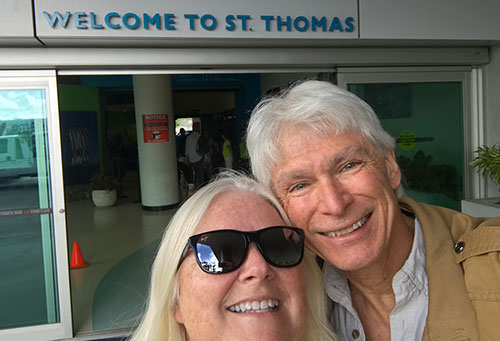
If it weren’t for the airlines' steadily sinking levels or service and reliability, the ever increasing cost and nickel-and-diming, and just their general obnoxiousness, it’d be remarkably easy to get to the Virgin Islands. No passport needed. No grumpy immigration. You deplane at St. Thomas airport and are greeted by friendly people, free Cruzan Rum samples, island music and most of the same amenities as in the contiguous United States. Luggage arrives quickly, no brigades of hustlers trying to sell you this and that.
Our friends had arrived a couple of hours earlier, picked up a rental van, checked in at the Margaritaville Wyndham resort where their time share ownerships grants them access to wonderful housing, and had braved traffic to come pick us up. It’s good to have great friends.
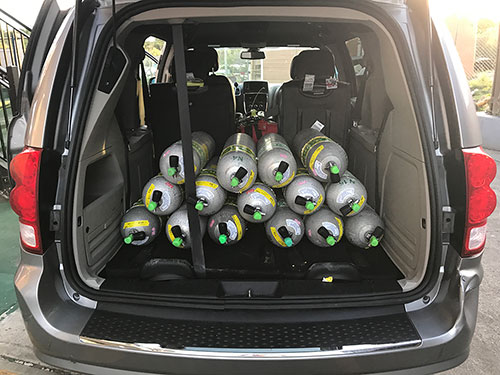
First stop was to pick up Nitrox tanks which, supposedly, are only available at one dive shop on the island. Upon checking pressure and oxygen content of every one of them, we loaded 16 tanks into the van and paid the rather exorbitant charge consisting of a nitrox fill, tank rental and tank off-site charge. Then starving, and sweaty from both the island heat and humidity and hefting the tanks, we stopped at the close-by Tap & Still bar & grill for some cheap whisky and truly excellent burgers, fries and chicken sandwiches, all served in individual greasy little paper bags.
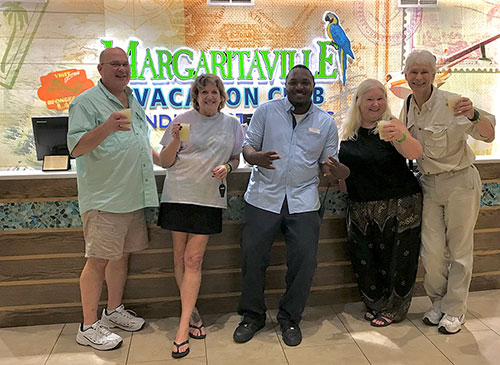
It gets dark early in the Virgin Islands in the Fall, like 6PM, and so it was pitch-black by the time we reached the impressive, gated Margaritaville complex on the beach and extending into the hills. We were greeted with, what else, Margaritas, hefted half of the 16 tanks into a storage room, then hopped on an elongated golf cart to be brought up to our duplex on the hill. Our two-story home away from home for the week was nice and modern, but also stiflingly hot. So we went cooling off in a wonderful red-light infinity pool higher up on the hills while the A/C kicked in. Which it wasn’t, and never would, and so we had to pack up again and move to another unit.
Being spoiled from having spent so much time at “dive camps” where sleeping accommodations are just steps away from the dock and boats, the logistics of getting gear from a place high up on the hills down to the parking lot and into a van, then driving up and down many more hills on the other side of the road to a dive shop on the other side of the island, were daunting. As was finding the grandly named but actually charmingly rustic Admiralty Dive Center in the old french part of Charlotte Amalie harbor.
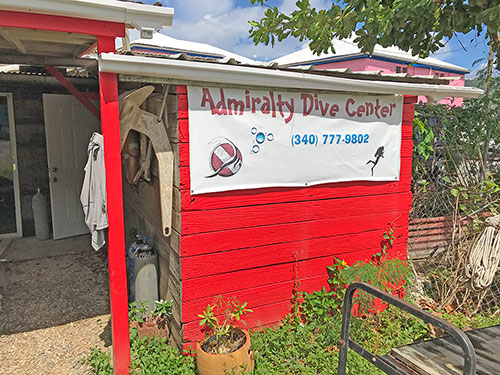
Then unloading everything and getting it onto the dock and into the nicely equipped dive boat.
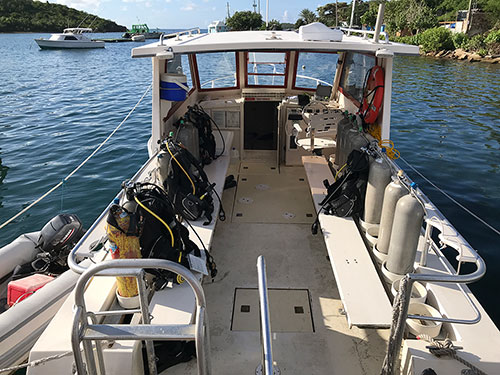
The island of St. Thomas seems to sit on top of a mostly flat expanse of sandy and largely featureless shallow sea bottom that rarely drops below 80 feet. That means dive sites are mostly wrecks, occasional underwater hills and rock outcroppings, some reefs, and sites close to shore where there can be coral fingers with sandy chutes in between them. The water was a balmy and consistent 86F, allowing wearing nothing but swimwear or perhaps a rash guard on top. We dove a variety of US Navy barges dating back to WW2, usually sitting in waters between 40 and 60 feet. Those had served as troop quarters and later sank, making for rather attractive dive sites.
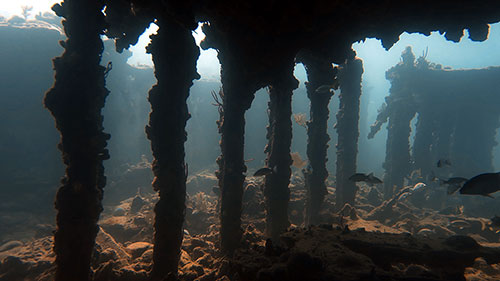
Our dive boat was unique in that it had a dive pig on board. Yes, Captain Jerry brought his pet pig Abby to ride along. Abby was well-behaved and did not seem to mind the boat trips at all.
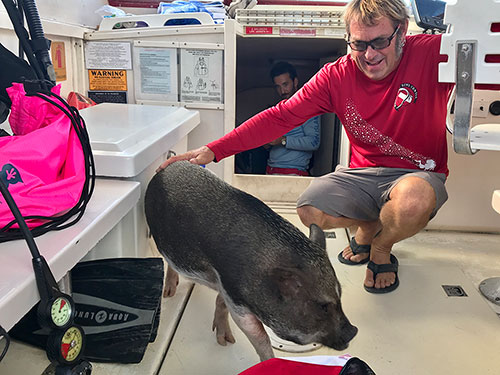
We had one scary incident. A lady in her early 60s had joined us for the morning dives. She had seemed somewhat uneasy from the start, though she described herself as an advanced level diver. The dive was to a 90 foot sandy bottom with a slightly elevated reef. The divemaster noticed her acting a bit strange and tended to her. She had enough air, but since it was a deep dive he guided her up. She, however, ascended too fast and then apparently lost control of her buoyancy and did not even make the 15-foot safety stop
Back on the boat she seemed increasingly uneasy. The captain and divemaster questioned her, helped her out of the sun and out of her wetsuit. This did not help and she vomited twice. The captain then aborted the trip and rushed the boat home, calling medical assistance and whoever else needed to be called in such a case. At the dock, the woman was helped up. She dragged one leg and had blotchy skin on her upper back. She was then lifted onto the dock and given 32% nitrox for breathing (no pure oxygen was on the boat). EMTs arrived with a gurney, questioned and examined her and then rushed her to emergency. Whew.
Below is a mapping log of one of our dive trips out of Charlotte Amalie on the Admiralty Dive Center boat with Captain Jerry Cowan.
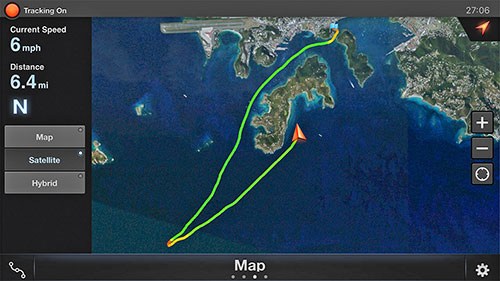
Having a rental van enabled us not only to make the trips back and forth from the place where we stayed to the dive shop and dock, but also allowed us to go grocery shopping and eating at restaurants without needed to call a cab. Driving on the left side of the road required some major adjustment with our designated driver constantly repeating her “stay left, stay left” mantra. She got used to it surprisingly quickly, but occasionally lapsed, making for some honking and embarrassment. Since all cars on the road seem to have standard lefthand steering one wonders why the US Virgin Islands haven’t simply switched to driving on the right side of the road long ago. Tourists, of which there are plenty, would be grateful, there’d be fewer accidents, and the logistics of switching would be relatively simple.
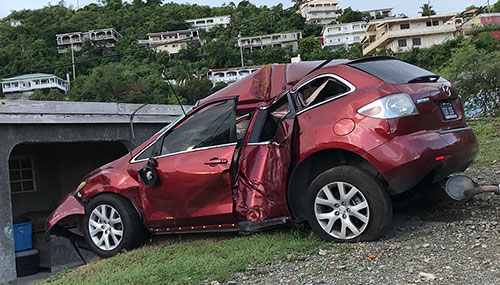
We went for a food run to one of the local supermarkets where prices were, on average, about 40% higher than in the US. Gas ran close to $4/gallon, almost twice what we pay back home in Tennessee. How do locals afford that? Are there two economies, one for tourists and expats, and one for locals? Everything else is also expensive. A taxi ride from our Margaritaville resort to the airport, which isn’t THAT far, is $58 per person, plus luggage fees.
Also interesting is that the US Virgin Islands have no sales tax to help pay for an elaborate infrastructure costly to maintain. The entire situation is unique. When one looks onto most maps, it’s difficult to find the US Virgin Islands. They are together with the UK Virgin Islands, just a group of small islands. St. Croix, which is also part of the US Virgin Islands is quite a ways away, whereas the island of St. John is right next door.
Compared to other Caribbean islands, not everyone is friendly. While we met many enthusiastic, helpful people, a good number were on the surly side, less than helpful, and seemingly quite disinterested in making customers and tourists feel appreciated, let alone welcome.
Overall, the diving was so-so. It’s mostly sandy bottoms, though there certainly are nice sites. That’s because the whole area is geologically a “back reef lagoon/shelf." Reefs here and there were formed when sea levels were at temporary stand-stills.
During our stay, the consistent 86 degree water made it unnecessary to even wear a wetsuit. I wore dive pants and a rash guard. We saw lots of life around and in the wrecks, and also interesting things like small schools of squids in the reefs surrounding islands.
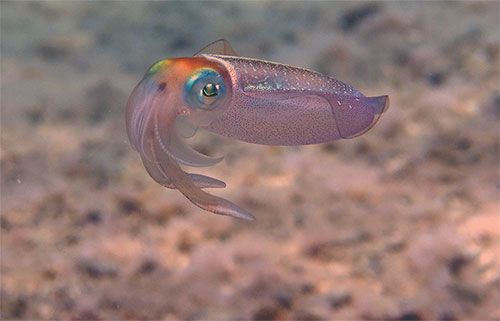
The most serious issue is massive smothering by phaeophytes algae, mostly the dictyota brownish mesh algae that is also all over the waters around the Honduran island of Roatan.
But whereas in Roatan dictyota is just the third-worst plague, at the Virgin Islands with its expanses of flat sea bottoms and reefs, it’s the primary threat, being virtually everywhere and covering almost everything. In addition, the unusually warm water have contributed to widespread coral bleaching.
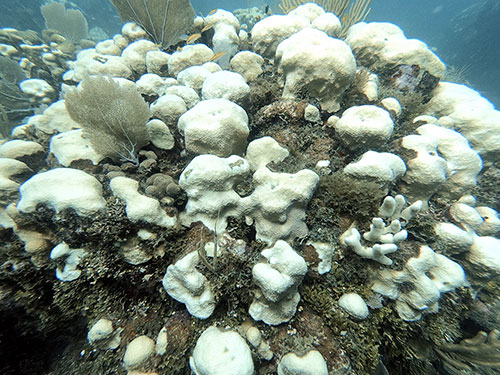
Memorable dives included “Packet Rock,” a pinnacle covered with yellowish-brown coral that makes for dramatic fly-overs. The name comes from steam ships of the Royal Mail Packet company that hit the rocks in the 19th century and sank here, spilling their cargos.
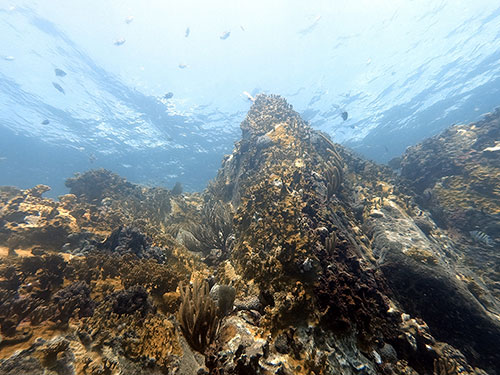
As the dive boat appraoches the famous rock you won't see it at first (just like all the sailing ships that have hit over the last 200 years), but eventually you see light yellow-brown color just beneath the surface, like someone poured mustard in the ocean. That is Packet Rock.
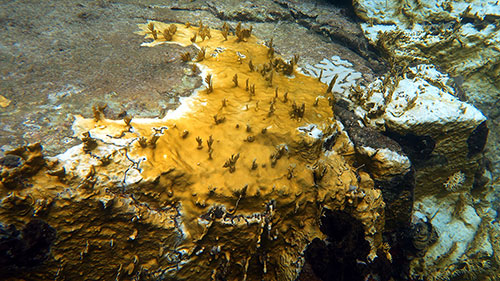
Packet Rock makes for an interesting dive site not only for its picturesque yellow pinnacles, but also for the wealth of roof tiles and thousands of broken pottery shards, and glass of all kinds that can still easily be found in sands and pebbles around the pinnacles.
Another fascinating dive was to the “W.I.T. Concrete,” a 400-foot concrete oil tanker sitting upright in maybe 90 feet of water.
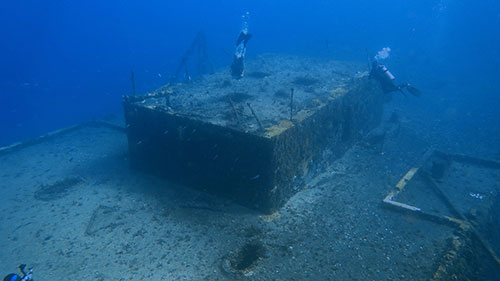
Some research revealed that the "W.I.T. Concrete" was most likely the "Concrete 2" YO-144 that was built in 1942 by Concrete Ship Constructors in National City, California. YO stood for "Yard Oiler." The YO-144 was renamed to YON-144, where the additional N meant she was not self-propelled, but moved by two tugs attached to each side. The YON-144 served at Yokosuka Naval Station in Japan, was later moved to the Philippines, and somehow ended up off St. Thomas.
And this is what the concrete ship looked like back in 1943:
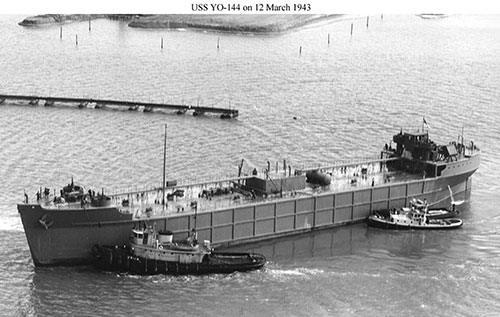
Overall, we did about a dozen dives off the coast of St. Thomas. Anytime one gets to go underwater is a treat, and if the scenery above ground is as dramatically beautiful as it is around St. Thomas with all if its islands, that goes double.
The waters, by and large, were blue and clear, the wrecks are all interesting and engaging to dive, we saw sharks on several dives, as well as turtles, rays, eels, groupers and much more. Diving, as everything on the island, is expensive. Even bringing our own (very expensive) nitrox, it still cost Carol and I $240 per day for just two dives each. Plus tips. That is on the border of what is still affordable for us.
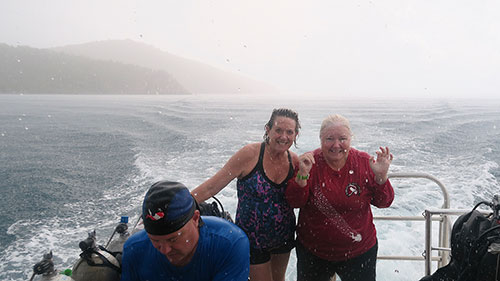
Posted by conradb212 at 5:30 PM
June 8, 2019
South Florida Diving June 2019
Once again we’re spending a week in South Florida with our dear friends Tom and Donna. Once again we’ll be staying at the Wyndham Santa Barbara in Pompano Beach, but our diving will be different. We’ll drive down to Miami and dive there, drive up to Jupiter and dive there, dive the famous Blue Heron Bridge, and then, also, we’ll dive with the folks at Pompano Beach Scuba.
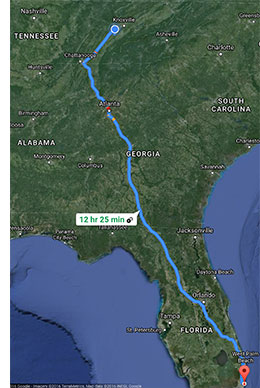 It’s a long drive from Knoxville, Tennessee, to Pompano Beach, Florida. About 820 miles. We got up at 3:15AM, left at 4:15AM, Tom and Donna in their big Ford F350 Diesel truck, Carol and I in my Hyundai, Ioniq. We took our own tanks and weights, Carol’s two 60s and my two 100s, all steel.
It’s a long drive from Knoxville, Tennessee, to Pompano Beach, Florida. About 820 miles. We got up at 3:15AM, left at 4:15AM, Tom and Donna in their big Ford F350 Diesel truck, Carol and I in my Hyundai, Ioniq. We took our own tanks and weights, Carol’s two 60s and my two 100s, all steel.
We stopped at one of the world’s worst McDonalds south of Atlanta and then a much better one somewhere in South Georgia. The ioniq made a very nice long distance vehicle. The first tank yielded 55mpg, the second 52mpg, remarkable for a fully packed vehicle and going at a good pace, generally 75-85.
We spent much longer than anticipated at the Florida Welcome Center just past the Florida state line. The reason why we stopped there in the first place was because I needed a new transponder sticker for SunPass, Florida’s automated toll system. I already had an account, had added funds online, and all I needed was a transponder sticker for my new car.
But things had changed. The sticker was no longer free. It now cost five dollars. From a vending machine whose card reader was broken and when fed cash, returned the change in one dollar coins. And the new sticker needed activation at another machine that had a long line of people waiting. Activating online was impossible because, unbelievably, there was no cellphone signal at the welcome center. Staff couldn’t help and suggested we call SunPass. Which we couldn’t, due to lack of signal. When I finally found a weak signal a ways away, the formerly trim and quick SunPass app was sluggish and bloated. And the app was nearly incomprehensible and infuriating to use. I wasted close to an hour trying to do something as simple as activating a sticker. Very annoying. Not progress, Florida.
Traffic on a Saturday was awful, and then we encountered torrential rain. This was quite different from earlier trips with fond memories of barbecues and boiled peanuts. But that all was quickly forgotten as we settled in at our home for the week at the Pompano Beach Wyndham.
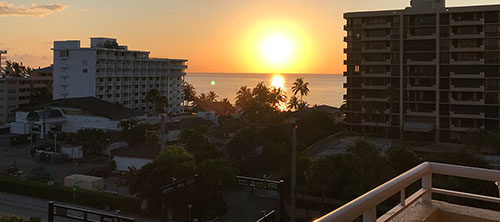
Sunday, June 2nd -- No getting up early for our first dives of the trip. That’s because we drove down to Miami Beach for a couple of dives with the Tarpoon Dive Center. When one thinks of Miami these days what comes to mind isn’t so great, but everything certainly still looks grand and impressive and much like the old Miami Vice. Tarpoon is in a big modern building right at the very bottom tip of Miami Beach by a fancy marina. There was a brand new Rolls Royce convertible with a young couple and lots if luxury vehicles. The dive shop, inside, looked cozy and old style.
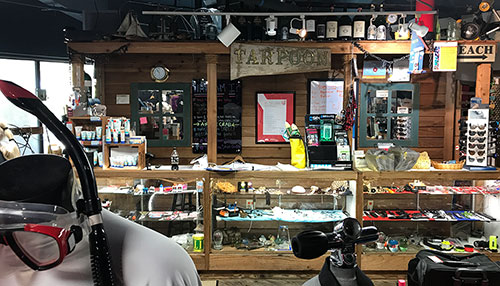
We thought we’d be in a very small group to go out diving, but it turned out to be a very large one. 38 people including, or perhaps on top of, a good number of snorkelers. It was very hot and humid and by the time we finally got going, we’d been placed in the baking sun on the fairly large boat.
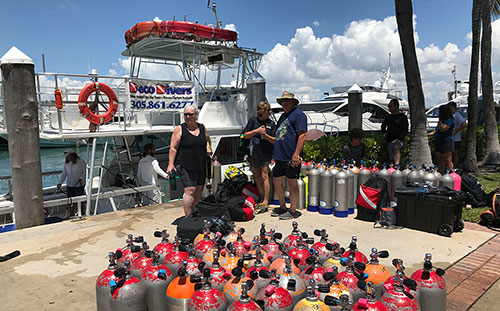
The ride out was smooth and the first dive on a very shallow reef, Falcon something. It was all of 20 feet, had some current, and was, by most reef standards, unexceptional, with so-so viz. It was, however, an opportunity to get acquainted again with dive gear after our last dives last September. For me that included a brand-new Scubapro Hydros BC that turned out to be great.
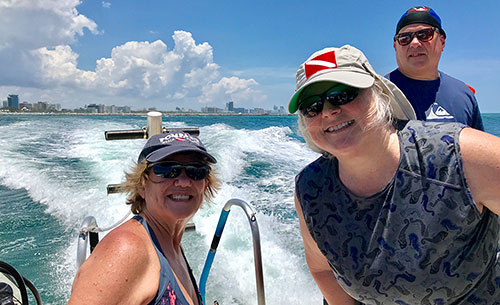
Back on the boat we pretty much immediately motored to our next site, an interesting one named the Neptune Memorial Reef, fashioned, supposedly, after the lost city of Atlantis. It sits at 40 feet on a sandy flat and is in essence a cemetery. A grand one that reminds of sunken Greek or Roman ruins, with columns, mausoleum style settings, statues, etc. People’s ashes are embedded in shapes of starfish, turtles, sea shells. It’s both eery and grand, and the slight murkiness added to the impression.
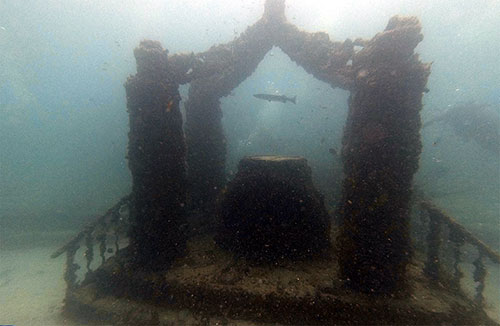
Back on the boat it was rushing to get out of the gear and pack everything up because the charter had another load of divers and snorkelers waiting. A loud, forceful captain lady did a good job, but overall this was a mixed experience. And by the time we were done it was already too late to have the anticipated dinner there. We had to get back to Pompano Beach to drop our tanks off.
I had taken my new GoPro 7 Black on the dives, and here the impressions were mixed as well. The battery life is as dismal as I remember, and the GoPro often does what it wants instead of what I want. The latter is partly my fault, because I can neither see the tiny menu nor soI know yet all of the GoPro’s new tricks. I did find out, however, that between WiFi on the 7 Black and the latest GoPro app, transferring images and video to the iPad is almost automatic. On the flip side, it all gets transferred into a somewhat opaque GoPro app that wants to hold onto it, create movie compilations, and save it to GoPro’s own cloud. Just getting it into Photos on the iPad takes some doing.
Monday, June 3rd -- The plan was being at the Pompano Beach Dive Center for two deepish wreck dives, the Lady Luck and the Captain Dan. As it turned out none of those happened, at least for Carol and I. While the water was quite calm on the surface, there was substantial current. So much that the buoy was immediately pulled way below the surface. The captain said conditions were borderline for a dive, but sent the two diver masters down to assess the situation. When they came back up word was that there was indeed ripping current and visibility was poor. This was going to be a holding on to the anchor line with both hands both down and back up, and caution down at the wreck. Carol and I decided to pass.
The rest jumped in and were quickly pulled away. After a couple of minutes Donna resurfaced and tried to get back on the boat. That was impossible and she was pulled under the boat. Eventually they told her to just let go and the boat would go get her. That worked. A few minutes later, a rebreather diver, a former Navy aviator, also came back up. The current was so bad that it had ripped his gloves apart. He decided it wasn’t worth even reaching the wreck.
Amazingly, the rest all made it back okay. The captain decided to cancel the second deep wreck dive, that one to the Captain Dan. So we did a drift dive instead, and then two more drift dives in the afternoon. They were all at around 60 feet and, for the most part, fun. Each time we followed a dive master. Each time we saw massive turtles, HUGE. Back on land we were totally bushed. Went for pizza in the little strip mall on the next block where a single pizza, excellent, was big enough for at least two people.
Some observations: for the dive boat, take along plastic ziploc bags, gallon size, to put stuff that needs to be dry. Whatever you bring to wear, it needs to be loose so that it goes on easy. Salt water makes you so sticky. Bring a towel and put it somewhere in l of the boat. And, once again, I so wish dive operations would make it clear what is expected of tips. As is, it is a mess.
Tuesday, June 4 -- Waking up to a great sunshine and flat water. Carol has a headache and decided to sit today out. I will go but if the current remains as is, I can’t see going down to two deep wrecks.
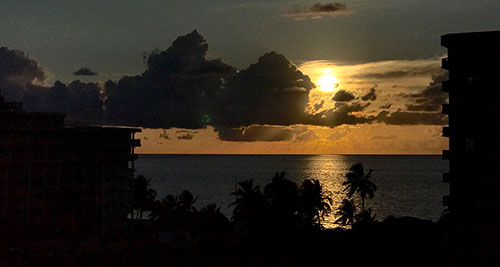
And here’s what happened. The sea was nice and flat, but as we learned that can be very deceptive. Once we got out to the site of the Captain Dan wreck, the buoys there looked like they were waterskiing. It took the captain three attempts to drop off the two dive masters so they could go down to the wreck to see what the situation was. They were back quickly. Way too much current and poor visibility. “No way†said the captain. The problem now was that onboard was a truly surly and unpleasant female tech instructor or some such who insisted she had to take her charges to this and that wreck and to this and that depth. So since tying up on any wreck that suited her was not possible, the captain suggested dropping the tech folk off at some deep where they could have enough depth, and then send us off on a drift dive where we’d see a series of tugs and the sharks that hang out there.
Sadly, the dive master missed the location, seemed to want to go back up, but then changed his mind and went on a drift dive. A few minutes into that he seemed to change his mind again, handed Donna the flag, and left. So we did the drift dive by ourselves. It wasn’t great scenery as the reefs here all seem choking on that small-leaf algae. It still was a nice dive. We went up after 65 minutes or so (for which Donna got a reprimand on the boat for taking too long).
The captain announced that we were now tied off to the wreck of the Okinawa, a relatively small boat (160 feet or so) that we had been to two years ago eight after it had been sunk. The current was supposed to be much less now, and divers were welcome to go down.
Well, the current did not seem less at all. Merely pulling oneself down to the wreck was nearly impossible. It was so strong that it tore the lanyard to my camera setup which, fortunately I had held in my hand when the lanyard broke. It took a long time to get down. The current was just as strong at the wreck and I had to hold onto the (already surprisingly encrusted and deteriorated) wreck. The current was a bit less on the far side of the boat, and I actually ventured inside the hull where there were thousands of fish, including barracudas.
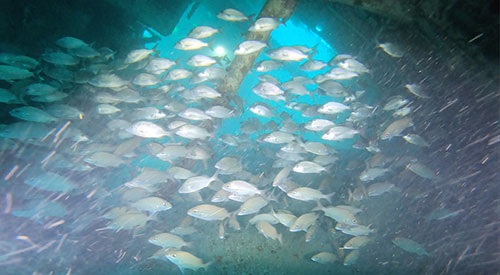
Conditions were such that I decided to go back up after only 25 minutes or so. And that was just as hard as going down. At the surface I found Donna hanging in the buoy line, but no boat anywhere near. So we hung in for dear life for at least ten minutes, and that was not pleasant. I didn’t want to let go and be blown out into the ocean. Eventually the boat did come to get us. What a trip.
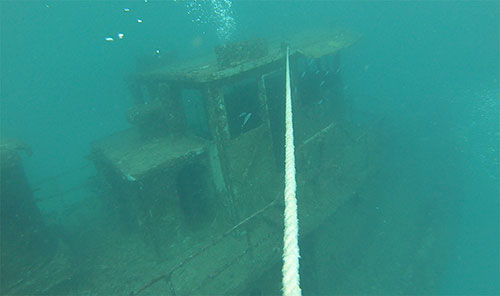
So I skipped the afternoon dives and washed my gear instead. Carol still wasn’t feeling well. For real estate it’s location, location, location. For diving it’s definitely, conditions, conditions, conditions.
In the evening we had dinner with our friends George and Cathy Cather, whom we had met in the Turks & Caicos Explorer in 2009. It was nice to reconnect, even though the Black Stone Bar & Grill mightily struggled.
Wednesday, June 5 -- And today we’ll dive the Blue Heron Bridge. It connects the mainland across the intracoastal waterway with the barrier island strip that’s along most of southern Florida. It’s a bit north of West Palm Beach and the barrier island part is called Singer Island.
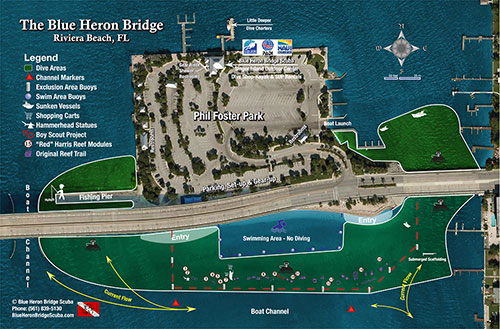
We did, sort of. It was a longer drive with more traffic than we anticipated, but we made it on time. The couple that parked next to us gave us helpful tips, or so we thought. In essence, there’s a park north of the bridge for fishing and camping, and a rather nice sandy beach on the south side. Part of that, a rectangle, is reserved for swimming. To the left and right of that are entries for divers. Depths there are 20-25 feet and there is supposed to be lots of life and things to see.
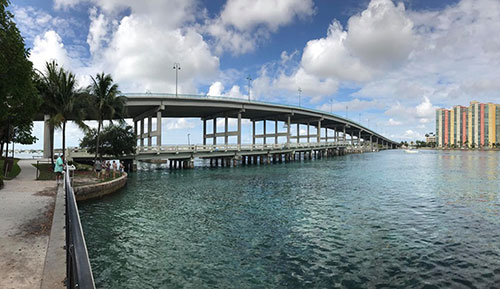
The area past the swimming rectangle is what’s called the snorkeling trail, which is just ten feet deep and designed for snorkeling with submerged structures to look down onto. The way we interpreted the information the couple had given us, we swam through the swimming area, then made a right that got us onto the snorkeling trail. Which was okay, but was very sparse and had poor visibility. We did a 72 minute dive that way, feeling let down. Also, we had felt a bit cold in the 79 degree water.
Back at the truck, a woman diver who was parked next to us had done it the right way, had been underneath and past the east bridge with the pillars, been in 22-25 feet, and had actually seen two manta rays!
The drive back was marred by Tom’s truck having A/C issues that even a recharge bottle from an Auto Zone store could not fix.
We later drove up to Jupiter to see the dive venue/pier, which is lush and tropical. We saw the dive boat return, and it was nice, too, with a red dive flag design paint job. However, the water is scheduled to be 65/67 degrees!!! Way to cold for our gear. I have no idea where that cold water could possibly come from. Donna called the dive shop later in the evening, and all she could get out of “Wild Bill†was that the water was 65 degrees. NOAA says 81, so I have to assume the 65 is some thermocline at some depth at some site, but “65†was all Donna could get from the dive shop. So weird.
Also.... EVERYTHING I wear on a dive trip MUST HAVE A ZIPPERED POCKET.
Thursday, June 6 -- And since, apparently, the Jupiter dive shop insists that the water temperature is 65 degrees, we decided to write that operation off and go back to the Blue Heron Bridge. This time armed with research and the proper information.
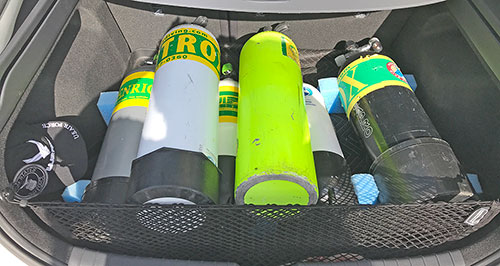
The tide is important when diving the Blue Heron Bridge, and it varies from day to day. Yesterday high tide was at 10:21AM, today it was 11:12. It is suggested to start the dive half an hour before high tide and finish it half an hour after.
It was brutally hot and I was once again reminded what a physical sport scuba diving is. Just packing one’s gear and carrying it around is a full workout, and putting it on another. Then it’s also infuriatingly possible to forget something, and that’s not good in a sport where everything matters or is imperative. This morning Tom forgot his mask and I my dive socks.
Anyway, we did make into the water and, this time. headed in the right direction. As soon as we entered the channel water was rushing upstream with the tide, and that made for a substantial current. So we held on to whatever we could and slowly moved underneath the bridge. You’d think there’d still be plenty of light there, but you’d think wrong. It was quite dark and the many pillars look overgrown and worn and ghostly. Everything is teeming with life and out if near darkness came a giant Goliath Grouper. Huge.
Overall, the wildlife under and around the bridge is astonishing and you never know what you’ll see next. There is a lot of soft red sponge where sea horses have been seen. After almost an hour and a half in the water, we felt the tide coming back the other way, which made for a nice gentle ride back underneath the bridge.
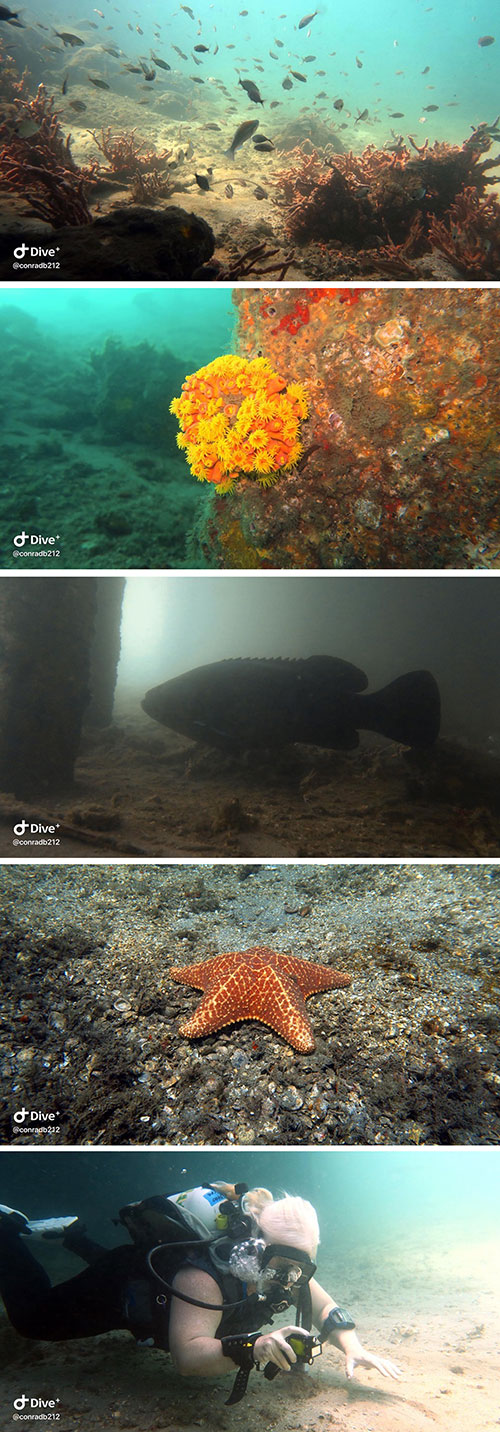
So this second attempt was a big hit.
After a bit of relaxing we walked over to the beach on the other side of the road where the Wyndham Santa Barbara is in, which is quite expansive, with very nice sand, and with very few people. Nice.
In the evening we were so exhausted that we all called it quits at 9PM. I was out like a light. I do take both pride and comfort in knowing that I can still do and enjoy all of this at age 68, but I am also not unaware that some of it is a bit more difficult.
One thing that has absolutely baffled me on this trip is that dive shop in Jupiter that reports those ultra-low temperatures. Every day, after the boat is back in, they publish a group picture of all the happy customers on the boat and report visibility, waves, current, and temperature. So you read 65F and 10 foot visibility and nothing else. Which would make diving unpleasant and/or impossible, because people do not come to South Florida in June with 7mil wetsuits and all the protection needed to dive in cold water.
I’d understand if the dive shop warned that on some dive sites there might be a thermocline at such and such depth. We’ve experienced that in Pompano with a wreck where at 80 feet or so the water temperature went from 82 to 65 on the wreck. That was so cold that Tom, who usually dives with just shorts and a shirt, stayed above the thermocline. But that is the exception and not the norm. Why a dive shop would list the worst conditions encountered and not the entire situation is beyond me. Do they want to drive away customers?
In dealing with this dive shop, Donna made every effort to get them to tell us the whole situation. With NOAA reporting 82 degrees in the surface at Jupiter, you’d expect a dive operator to tell you what customers might have to expect, and also to take them to dive sites that are reasonable for diving. But no. The answer always was 65 degrees. We can’t predict what’s happening. No further information.
Go figure.
Friday, June 7 -- Last diving day of the trip already, and also Tom’s birthday. The plan is to go up to Riviera Beach again and do another dive at Blue Heron Bridge. Diving is free there, which makes up a bit for losing the prepay at the weird Jupiter Dive Shop with its arctic temperature reporting. This time we’ll explore the western side of the park, the side towards the middle of the inlet.
As it turned out, the Western part of Blue Heron Bridge is a very different dive than the Eastern side. It is a significantly larger dive site since one can dive almost all the way across the waterway, until one gets to the boat channel. It’s shallower, mostly between 7 and 15 feet. And while on the Eastern side it’s dark and forbidding under the bridge and between the pillars, the Western side is much brighter. There is, however, just as much life there, and it’s endlessly entertaining. Strict observance of the tide is imperative, or else you spend much of your time fighting the current. We saw several skate sleeping/resting on the bottom. These are small rays without a sting. One was being encroached on by one of the plentiful very large starfish, suddenly realized the offense, and took iff like the proverbial bat out of hell. Lots of arrow crabs, many schools of fish, endless tiny little things to see. What a wonderful dive.
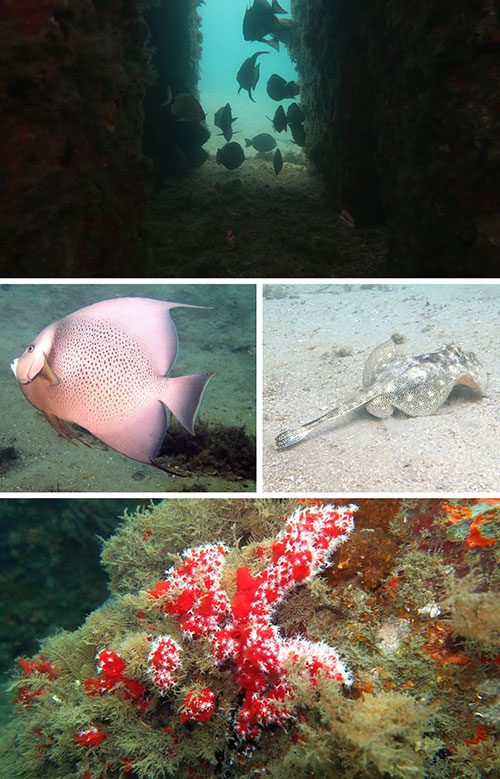
And also a long one. Mine was almost two hours and I had plenty of air left. Carol did well over two hours. Note to self: always bring a scribble pad. Underwater it is exceedingly difficult to communicate.
I commented on Facebook the unacceptable customs at that strange dive shop in Jupiter that seems determined to drive away customers after having collected their pre-pid money. Just some snarky responses and nothing else. What a rip-off. I wonder how they can be in business.
To end the day we had a nice birthday dinner for Tom at Flanigans.
Saturday, June 8 -- Got up at 5:30... love my quiet coffee and time to think and contemplate. Soon we’ll tackle the 820 mile trip back up North to our home in East Tennessee. It’s been a great week.
The drive took us about 12-1/2 hours. Left at 8:30am, arrived at 9pm, and that was with obnoxious traffic getting into and through Atlanta. It is amazing how inexpensively travel can be with. fuel-efficient vehicle. My 2018 Hyundai Ioniq hybrid got 54.6 mpg on the first tank, and 57 mpg on the second. All in all a tank and a half, 15 gallons. At US$2.50/gallon that’s $37.50 to get from South Florida to East Tennessee, with four big scuba tank and lots of gear.
So what’s this trip been all about and what have I learned? It’s been lots of fun. Going diving with good friends adds a lot. One needs a check list not only to make sure everything is packed fora dive trip, but also every time one leave the room in the morning to go diving. It is so easy to forget something. Even a little thing can be a big thing when it comes to scuba diving.
One day I forget to bring dive socks. No big deal one might think. But it is. Without them you can end up with your feet scraped raw and bleeding.
One day Tom forgot his mask or it hd gotten lost or stolen. You can’t dive without a mask. Fortunately, this was a shore dive and he could drive to. nearby dive shop and buy a new one,
Since I was diving with a new BC for the first time I neither had the inflatable safety sausage that is usually in the pocket of my old BC, nor my knife. Both would have come in handy.
The safety sausage when I surfaced from that dive to the wreck of the Okinawa and there was no dive boat and I had to hang on to the line in ripping current. With a safety sausage I could have let go, knowing that the bright orange sausage made it easy to see me in the open ocean. The knife when we were diving the Blue Heron Bridge where there was a lot of fishing line. I was lucky that I did not absolutely NEED the sausage or the knife, but it could have been different.
Another thing I learned was to keep batteries away from wetness, even if they are in supposedly watertight packaging or baggies. I had kept backups for both our dive computers and the wireless integrated air transmitters in the box I keep the computers in. Well, both a 3 Volt Lithium and a button cell got destroyed just from the moisture.
I also learned not to trust dive shops. While everything worked out one way or the other, being on a boat with 38 divers in Miami was stressful. They should have told us how busy it was going to be. And never prepay all your dives with any dive shop. The experience with Jupiter Scuba Diving where we lost all of our money was a lesson I won’t forget
Posted by conradb212 at 5:56 PM
August 2, 2016
Diving the North Carolina coast
The waters off the coast of North Carolina are known as the Graveyard of the Atlantic. That's because when the warm Gulf Stream meets the cold Labrador currents, things can get quite rough. That primarily goes for North Carolina's Outer Banks, that thin strip of sandy dunes that can be as far as 30 miles away from the mainland. South of that, starting at Cape Lookout, is a less rugged and mostly south-facing 85-mile stretch known as the Crystal Coast where, according to tourist brochures, the waters can be as warm and clear as in the Caribbean.
Having fond memories of summer vacations spent on the Outer Banks decades ago, we made the 530 mile trek from East Tennessee to Morehead City for a couple of days of diving with the folks of the Olympus Dive Center, which is located on the peninsula facing Bogue Sound. The company began as a boat charter business over 40 years ago, the dive shop itself was built a few years later, and their primary dive boat, the 65-foot Olympus, has been serving divers for 30 years.
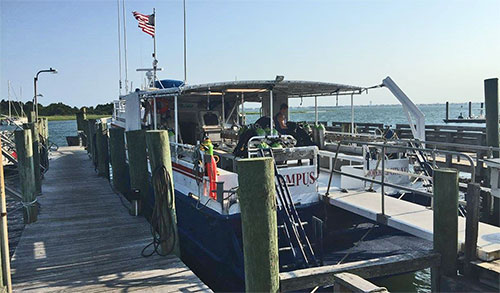
Like most well-established dive shops, Olympus is an interesting place. There's an eclectic mix of ScubaPro and other dive gear, useful accessories, spare and repair parts, bags, cameras, lights, clothing and also numerous fascinating mementos from decades of exploration under the seas. The shop's founder, the late Captain George Purifoy, is credited with having discovered and identified several major wrecks, most notably the USS Schurz, a 295 foot World War I cruiser that sank in 1918, and the German submarine U-352 that went down in 1942 after mistakenly taking on a US Coast Guard cutter and getting the short end of the deal (read Coast Guard sinking of U-352).
Needless to say we wanted to dive the U-352 as, given the notoriety of the Nazi wreck, we assume most divers new to the area probably would. We put our gear on the spacious dive deck of the Olympus, set up what could be done ahead of time, and then retired to our home for this trip, the Island Inn across the Atlantic Beach Bridge over Bogue Sound. Alarms were set for 5AM as divers were expected at the dock by 6AM sharp.
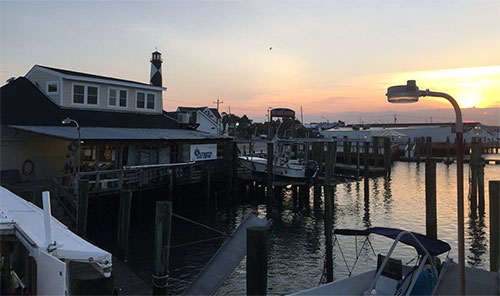
We had brought our own tanks and they were still filled with 33% Nitrox from a prior trip, too "hot" for the 120 to 130 feet of the deeper wrecks we planned to dive. We had that toned down to 30%, good for a maximum depth of 124 feet when observing a PPO (partial pressure oxygen) of 1.4 atmospheres.
The Olympus left port around 7:30AM, after every diver had collected a numbered "boarding pass" and given it to 1st Mate Bud Daniels so he could do his roll calls after every dive — a clever solution of keeping track of divers and making sure they're all present and accounted for after a dive.
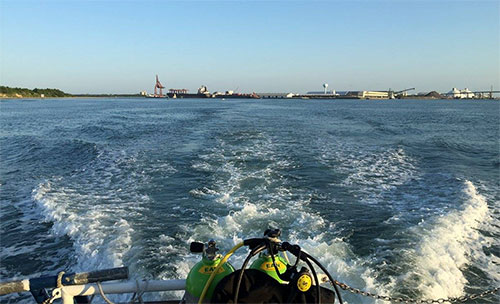
This is when we began learning the realities of North Carolina diving. Unlike in most parts of the world where there's a set schedule of dive sites every day, or where divers can request a site, off the coast of North Carolina it all depends on the conditions. No matter what the weather forecast says or what the skies look like, the situation out on the open sea may be different, and it can change at the drop of a hat. So the Captain, in constant communication with other boats and various services, decides when and where to go.
How can it be so difficult to figure out what conditions to expect? That's because the Eastern continental shelf is relatively shallow and one has to travel pretty far out on the open sea to reach depths of 120 to 130 feet where most of the interesting historic wrecks lie. That means 30 to 40 mile boat trips right to the border of the gulf stream where currents and ever-changing temperatures mean anything can happen.
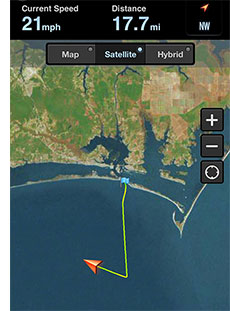 For us, the initial word was that it was 50/50 on whether we could make it to the deep sites. Once past Beaufort Inlet, where the incoming swells mean it's always rocky, the seas were not too bad and after half an hour or so the Captain announced we'd be headed for the wreck of the Aeolus, a 410-foot tanker sunk in 1988 as part of the state's artificial reef program. The Aeolus now rests in about 110 feet of water, maybe 30 miles out. That was good news to us because the U-352 sits in the same direction, just another five miles farther out to sea. So we hoped to see the submarine on the second dive.
For us, the initial word was that it was 50/50 on whether we could make it to the deep sites. Once past Beaufort Inlet, where the incoming swells mean it's always rocky, the seas were not too bad and after half an hour or so the Captain announced we'd be headed for the wreck of the Aeolus, a 410-foot tanker sunk in 1988 as part of the state's artificial reef program. The Aeolus now rests in about 110 feet of water, maybe 30 miles out. That was good news to us because the U-352 sits in the same direction, just another five miles farther out to sea. So we hoped to see the submarine on the second dive.
It was not to be. A bit later, with the seas getting rougher, the Olympus made a hard turn to the right and word came from the bridge that the deep dive program had to be aborted due to unsafe conditions. Instead, we were now heading for shallower waters closer to shore.
We ended up diving the "inshore" wreck of the 330-foot freighter Indra, also sunk under the artificial reef program in 1992. Depth here was 65 feet, which made for a short descent and much longer dive time. Visibility at the wreck was maybe 45 feet, not tremendous and definitely not the 80-100 feet listed for the month of July and 100+ feet for August.
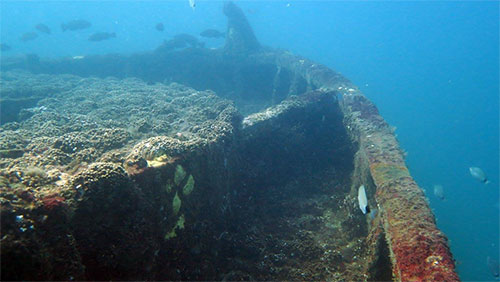
It was a pleasant dive in 81 degree water and also my first opportunity to experience the "Carolina Rig," which consists of weighted hanglines dropped off the middle and rear of the boat with a horizontal line at 15 feet between them, and a rope down to the anchor line in the front. That makes it easy to find the line down to the wreck, and also helps the 15-foot safety stop at the end of the dive and then heading to the back of the boat and to the ladder.
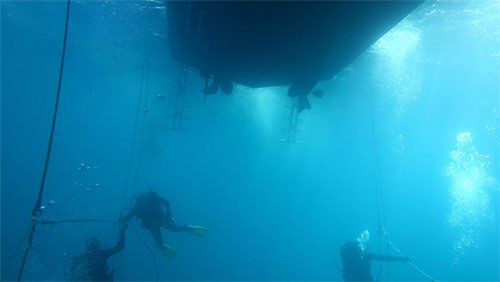
The second dive was to two tug boats — the James J. Francesconi and the smaller Tramp — that had recently (May 2016) been sunk near the Indra. Visibility was less, but still good enough to enjoy the dive and going to both tugs. What made this dive special were massive schools of small fish literally enveloping the wreck in ever-changing speed and formations. What made them stop and start was never obvious as they didn't seem to be afraid of divers. It was totally fascinating to watch them.
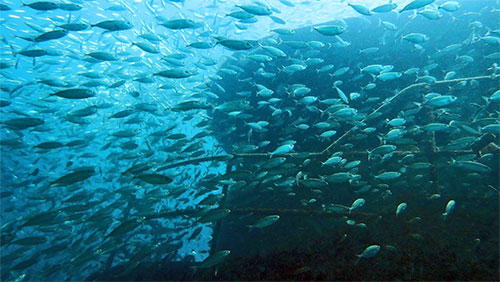
The weather forecast didn't look bad for the next day and so we had high hopes to make it to the U-352 after all. Our hearts sank when we saw divers who had arrived at the dock before us take a wait-and-see approach rather than preparing their gear on the boat. And sure enough, the Captain called us together and announced that conditions were rough again, and the most we could hope for was a trip to the shallower inshore sites.
After some more deliberations, the Olympus did indeed take off. The swells at the inlet were quite large and rocked the sizable boat. Once out on the open ocean it calmed down some, but we still saw whitecaps and hit the occasional large swell. The presence of whitecaps is usually our own indicator that it's too rough to dive. Not so much underwater, but getting back on the boat with the ladder slamming up and down. Half an hour into the trip the Captain called it off. Too dangerous. And that was that for us. On the way back through Beaufort Inlet, we saw a large sport fishing yacht almost flip over backward, so big were the swells.
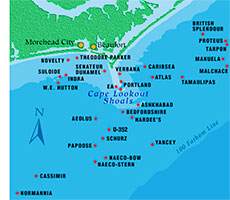 Our experience pretty much summarized the predicament of North Carolina diving. Trips to the deeper wrecks are long, which makes them quite expensive. The water is warmer farther out and the visibility likely better, but you truly never know if you can actually make it out there. On a good day it may be two great days of diving to where you wanted to go. On bad days you don't get to leave the dock at all. In between it's a maybe, and you don't know what to expect.
Our experience pretty much summarized the predicament of North Carolina diving. Trips to the deeper wrecks are long, which makes them quite expensive. The water is warmer farther out and the visibility likely better, but you truly never know if you can actually make it out there. On a good day it may be two great days of diving to where you wanted to go. On bad days you don't get to leave the dock at all. In between it's a maybe, and you don't know what to expect.
That makes planning dives difficult. Nitrox fills cost twice as much as air, and it's really wasted on shallow sites. Planning what gear to take with is difficult as well. We're usually testing cameras on every dive, and depth determines filters, lights and the type of camera we want to take with. Hotel accommodations are expensive, and staying without being able to dive quickly drives up the cost per dive.
While cancelled or aborted trips are frustrating for divers, it's much worse for charter operators who have to deal with disappointed customers. And they never know whether a fully booked boat will result in actual pay or not. The double whammy of environmental conditions and — in the absence of reefs or walls or many other interesting sites — being limited to the relatively small number of suitable ship wrecks makes diving the coastal waters of North Carolina an uncertain proposition.
I certainly don't regret the trip. I love long drives, we had great company in our friends Tom and Donna, the boat rides themselves were wonderful even without diving, the Olympus dive operation was great, and we got to experience not only the ever-changing and often dramatic North Carolina coastal weather and skies, but also managed some beach combing and sight-seeing. Fort Macon alone is worth a trip.
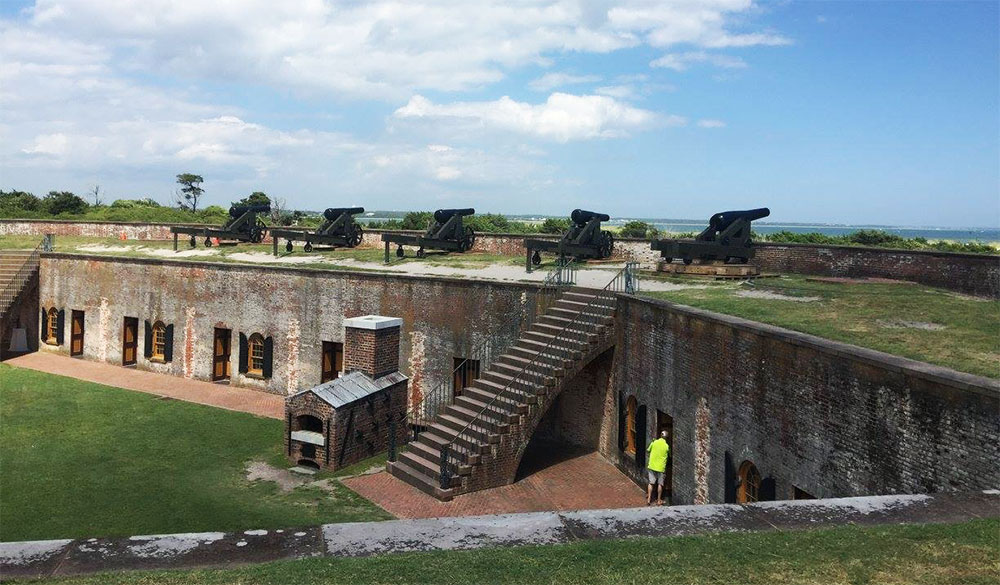
Posted by conradb212 at 11:34 PM
May 20, 2016
Diving South Florida May 2016
Sunday, May 8, 2016 — It's been almost two years since we went diving. The culprit was a combination of taking a breather after all those many dive trips that led to the publication of my book (Becoming a Scuba Diver), an increase in workload, and then preparation and execution of our move from California to Tennessee. We had postponed diving again and again. But that was about to change.
 Our friends Tom and Donna own a timeshare in Pompano Beach, Florida and invited us to come along for a week. Pompano Beach, just north of Fort Lauderdale, is within driving distance of our home in East Tennessee, and so we gladly accepted. We were to drive down, convoy style. Our friends in their mighty Diesel-powered Ford F350, we in the Prius.
Our friends Tom and Donna own a timeshare in Pompano Beach, Florida and invited us to come along for a week. Pompano Beach, just north of Fort Lauderdale, is within driving distance of our home in East Tennessee, and so we gladly accepted. We were to drive down, convoy style. Our friends in their mighty Diesel-powered Ford F350, we in the Prius.
Prior to departure we spent days going through our dive gear, some of which we first had to find in various parts of our new home where still not everything is where it should be after the move. We found things that didn't work. The battery in my Uwatec Galileo Sol dive computer needed to be replaced, and the battery of the wireless transmitter screwed onto my regulator was dead, too. The transmitter takes one of those button batteries, not the popular CR2032, but the less common CR2450. Fortunately, the local Walgreen's had one of those, and replacing it was easy.
I always suffer from logistics anxiety before a dive trip. Do I have everything? How do we get to the boat? What will the dive operation do and what do I need to do? What do I need to bring? Where can I stow my gear? Can I leave things at the dive shop, or do I have to take it back to where we stay? What temperatures can we expect, and which wet suit should I bring? And so on. These questions are always on my mind before a trip.
We got up at 3AM on Saturday, left at 4:30, and the 820 mile trip from East Tennessee to South Florida, though long, was pleasant. I had forgotten just how green and hilly northern Georgia is, and how much I enjoy long rides in a car where one can talk, relax, stop wherever one wants, and always has enough legroom.
I hate toll roads and mercifully Tennessee and Georgia don't have any. Florida does, though, but there's SunPass, an RFID-based electronic payment system. Interestingly, one can get the RFID sticker in a vending machine next to candy bars and salted snacks, and then easily activate it on a smartphone or tablet.
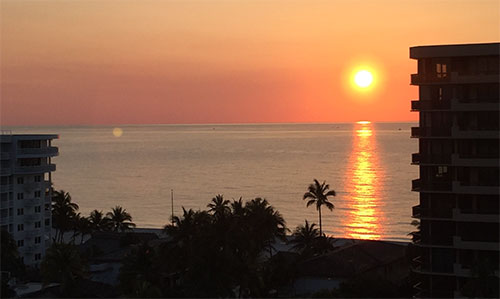
Once in Florida and all checked in and settled in our home for the week, the dive shop, Pompano Dive Center, turned out to be right next to a marina with their dive boats. I got answers to all my logistics worries, as I almost always do.
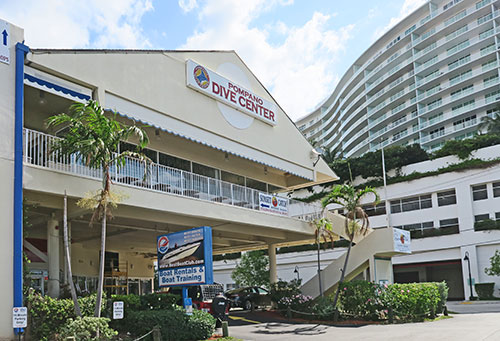
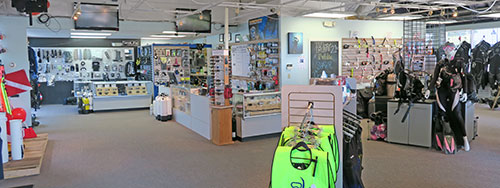
The marina was at an intracoastal waterway parallel to the beach. That meant motoring past gorgeous waterfront homes for a mile or so, under bridges and past boat yards before the captain could take the boat, the Sea Siren, out onto the open water.
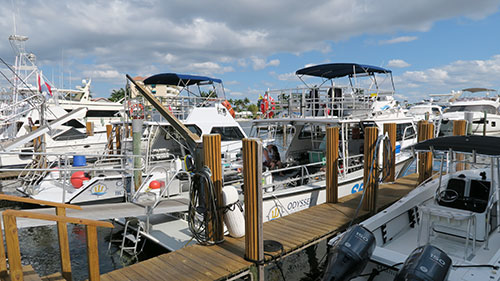
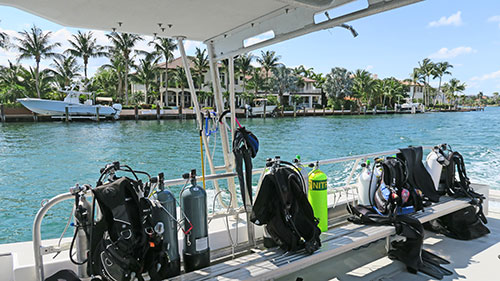
The first dive of the week was to the wreck of the Captain Dan, a 175-foot tender that was sunk as an artificial reef a quarter of a century ago. Opposite me sat five divers with rebreathers, which seemed incredibly complex to me. 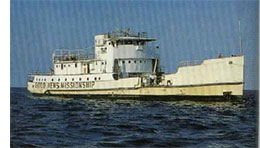 The idea of a rebreather is so simple: instead of wasting all this air by just breathing it out into the water as one does with open circuit scuba, rebreather divers are on closed circuit, where exhaled air is scrubbed of carbon dioxide, the inert nitrogen reused, and only as much oxygen added as is needed. But that's a complex mechanism, with sensors and systems and checks and balances.
The idea of a rebreather is so simple: instead of wasting all this air by just breathing it out into the water as one does with open circuit scuba, rebreather divers are on closed circuit, where exhaled air is scrubbed of carbon dioxide, the inert nitrogen reused, and only as much oxygen added as is needed. But that's a complex mechanism, with sensors and systems and checks and balances.
We had brought our own tanks, but I had never actually dived with the particular combination of suit and tank (5-mil wetsuit, 100 cubic foot steel tank) and so didn't know exactly how much weight I needed in the pockets of my BC. I probably didn't need any but decided on 8 pounds. We arrived at the wreck site, the boat tied off, and it was time to jump in. At 80 degrees, the water was warm enough to feel nice and pleasant.
After having stored my dive gear for two years and then moved it across the continent in a hot POD container before having it sit in a hot garage for another few months, I first had to shake an uneasiness about everything still working as it should. 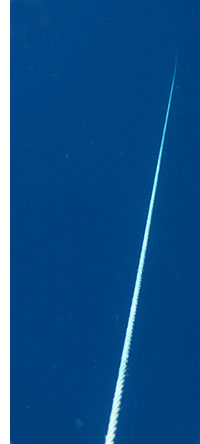 After all, scuba gear is life support equipment where failure is not an option.
After all, scuba gear is life support equipment where failure is not an option.
I've never liked anchor line descents, which is how it's usually done when you go visit a deep wreck. If you don't use a line and just float down you may actually miss the wreck, especially in current and poor visibility. But hanging on to a line that disappears in the distance is disconcerting to me.
This time I was glad that there was a line, because my completely dry wetsuit was too buoyant to let me descend easily even with eight pounds of weight in my pockets. Once down to 20 feet or so descending became easier.
There was no current and the visibility was reasonable. The wreck came into view, sitting on a sandy bottom. It was encrusted with all sorts of marine growth, and though it was pretty deep, the feel of this dive was considerably less intimidating than diving the wreck of the Yukon in San Diego at roughly the same depth. That's because the Yukon is usually in near dark, and the Pacific water is cold. The gloom of the Yukon prohibits even the thought of entering the wreck, whereas the warmer water and greater light almost invited exploring the insides of the Captain Dan.
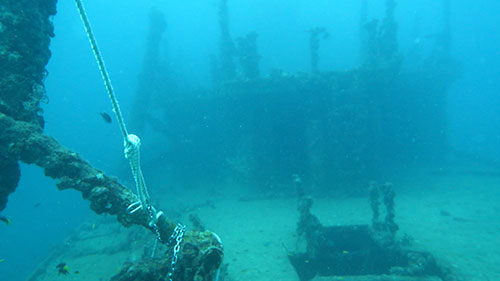
The wreck sat in sand at a depth of 110 feet. We touched bottom, then swam around the ship, and I quickly became more comfortable with my gear and being underwater again. Exploring was cut short, though, because even with 32% Nitrox in our tanks, bottom time at that depth is limited. Even with a slow ascent and the mandatory deco stop at 15 feet, it was a fairly brief 40 minute dive.
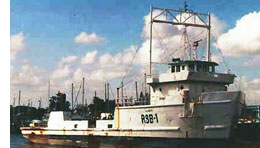 The second dive was at a similar nearby wreck, the 160 foot tender RSB-1. Normally diving starts with the deepest dive of the day and then proceeds to shallower ones, but the RSB-1 sat at 120 feet, so we had two fairly challenging dives right off the bat. Visibility at the bottom was quite good on this dive, probably 60 feet or even more, which meant we were in for a treat.
The second dive was at a similar nearby wreck, the 160 foot tender RSB-1. Normally diving starts with the deepest dive of the day and then proceeds to shallower ones, but the RSB-1 sat at 120 feet, so we had two fairly challenging dives right off the bat. Visibility at the bottom was quite good on this dive, probably 60 feet or even more, which meant we were in for a treat.
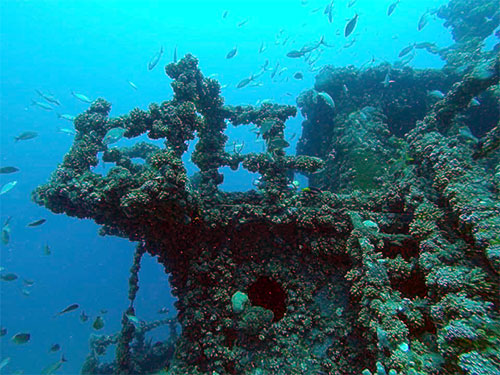
Seeing a coral-encrusted wreck that has been down for decades in good light and clear water is quite an experience. The difference between seeing a lot of a wreck and groping around in the near dark is vast. Unfortunately, even with Nitrox, exploring at 100+ feet meant that remaining bottom time quickly reached the single digits on our dive computers. and so this dive was over far too soon as well.
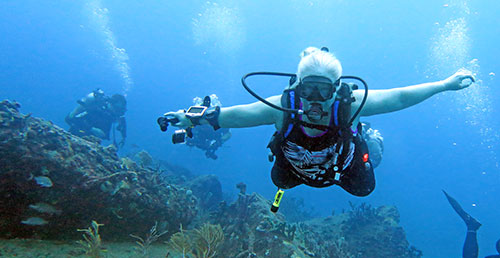
Speaking of dive computers, I nearly lost mine on this dive. At a depth over over 100 feet its wristband broke apart and it was only by coincidence that I happened to look at it just as it let go. It would not have tumbled into unrecoverable depth as I was hovering close to the sandy bottom when it happened, but I probably still would not have found it had it fallen off unnoticed. I always wear a backup computer, and so I could have safely completed the dive with the backup, but losing an expensive dive computer definitely is no fun. And the wristbands of expensive dive computers should not simply break.
Back on the boat it felt great to have reacquainted ourselves with diving again. And having ready access to a good dive shop came in handy, too, for the broken wristband of the computer. They didn't have a replacement in stock, but took one from a new computer and put it on mine.
Monday, May 9, 2016: Current — Normally dive boats go out on two tank routes, but sometimes it's three. And that's what we were going to have on our second day of diving off Pomano Beach, a three tank dive with an onboard barbecue. 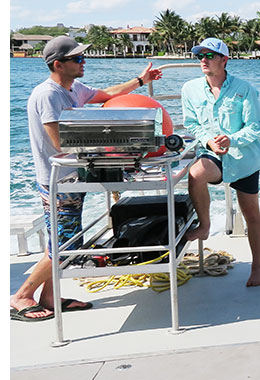 That meant having a grill and a lot of tanks on the boat, but there were only eight divers and so we could spread out.
That meant having a grill and a lot of tanks on the boat, but there were only eight divers and so we could spread out.
The sea was rougher than the day before and it was windy, so we were in for a bumpy ride, and a long one, too. All in all, between intracoastal and open water travel, it took a good hour until the Sea Siren slowed down for its first destination of the day. The MV Castor is a 258-feet ship that was sunk in 2001 after she had been seized by the US Coast Guard for transporting illegal drugs. Apparently, a good number of the scuttled ships off the coast of South Florida are former drug runners.
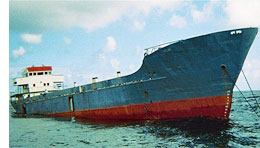 Once a dive boat arrives at a wreck location, which thanks to GPS coordinates and depth sounders is far easier than it used to be, the first thing is to tie off the line that goes from a permanent buoy to the wreck. If there is a permanent buoy, which isn't always the case. Then dive masters first must go down to the wreck to attach a line. The other reason for dive masters to go in first is to report on the conditions. Everyone hopes to hear that the visibility is good and there is no current.
Once a dive boat arrives at a wreck location, which thanks to GPS coordinates and depth sounders is far easier than it used to be, the first thing is to tie off the line that goes from a permanent buoy to the wreck. If there is a permanent buoy, which isn't always the case. Then dive masters first must go down to the wreck to attach a line. The other reason for dive masters to go in first is to report on the conditions. Everyone hopes to hear that the visibility is good and there is no current.
Alas, no such luck on that dive. The current was very strong, abating just a bit down by the wreck. That meant jumping in the water and instantly grabbing the line, or else one might get washed away. We did that, Carol and I, and began the ascent down the anchor line. The current was so strong that we had to hold on with both hands, pulling ourselves down hand over hand. Between the current, holding on to cameras, and clearing ears (which can be more difficult in strong current) it was slow going.
After what seemed like an eternity, the big wreck came into view and visibility turned quick good. The current lessened a bit, but not enough to make letting go of the line seem like a good idea. I chanced it anyway, dropping down to the sandy bottom at 115 feet in the hope of finding calmer waters there. That didn't happen and what one then does in such situations is hunting for spots with less current in and around the wreck. I found some places but still had to fight current, which makes diving that much harder.
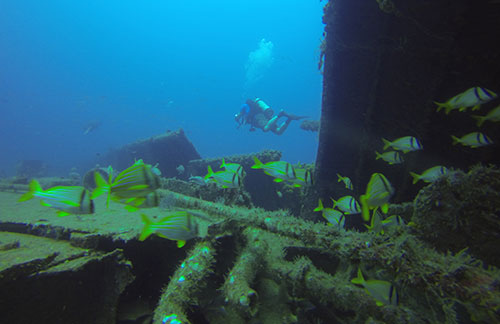
It would have been great to explore this whole very interesting wreck, the midsection of which had mostly collapsed. There was lots of life and much to explore. A big attraction here were the goliath groupers that had taken up residence in and around the wreck. They hung around, fearlessly eyeing us divers and being quite inquisitive. One seemed particularly interested in my bright orange ScubaPro Seawing Nova fins.
And then there are the colors that no one expects and which only reveal themselves in the beam of a dive light or a flash.
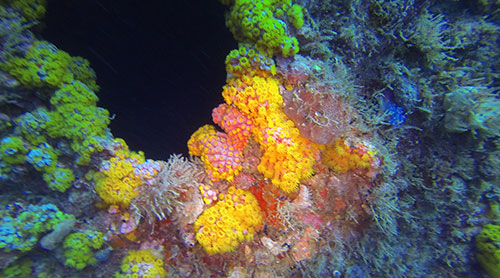
Since this again was a deep wreck, we had very limited bottom time before heading back to the anchor line for our way up. Finding the anchor line again is always a bit of a harrowing experience for me. Without the line ascent is difficult and disorienting in waters, and one might surface well away from the boat. I did locate the line and the current up was even stronger than on the way down. I was exhausted by the time I surfaced.
The buoy was now in front of the bucking Sea Siren and not in the back where the ladder is. I couldn't see a line around the boat and didn't want to let go of the buoy, but knew I couldn't stay where I was. The catch line, of course, was behind the boat with the current and I should have known that. By the time I climbed up the ladder I was panting and exhausted and felt quite sick.
I ended up passing on the second and third dive, feeling too queasy to get up. I even missed the barbecue. I don't know if I was seasick, but I felt miserable enough to wish I were in our room in bed without all the rocking. It was an unpleasant two or three hours until the feeling finally passed. During that time I felt like I never wanted to dive again. I also wondered what had happened to me, as everyone else seemed unaffected.
Tuesday, May 10, 2016: Rough Waters — We expected our week in Pompano Beach to be nice, easy diving, the sort of a tune-up we needed to reacquaint ourselves with diving. So far that hadn't been the case. Anchor line dives to deepwater wrecks, long rocky boat rides and strong current didn't qualify as easy. And so on the morning of our third day my stomach still felt a bit queasy. But there was another gorgeous sunrise and on the agenda was the Tracey a comparatively shallow (70 feet) wreck not too far away from our location.
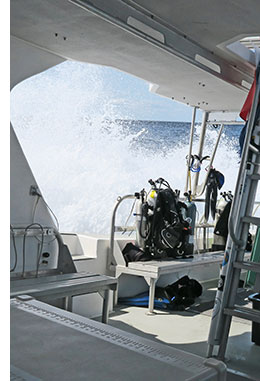 But Neptune didn't cooperate. As soon as we exited the intracoastal waterway and hit the open ocean the water was rough. The boat bounced and plowed through increasingly tall swells, with spray flying all over and things coming loose all over the boat. The usual 2-foot waves became four, five and probably even six footers, with whitecaps all over. Our fairly substantial 46-foot dive boat rocked enough to make getting off for diving seem hazardous, and getting back on the boat even more so.
But Neptune didn't cooperate. As soon as we exited the intracoastal waterway and hit the open ocean the water was rough. The boat bounced and plowed through increasingly tall swells, with spray flying all over and things coming loose all over the boat. The usual 2-foot waves became four, five and probably even six footers, with whitecaps all over. Our fairly substantial 46-foot dive boat rocked enough to make getting off for diving seem hazardous, and getting back on the boat even more so.
The conditions hadn't improved when we arrived at our destination, and Carol and I decided to skip the dive. In dive certification class, instructors are fond pointing out that there are old divers and there are bold divers, but there aren't any old, bold divers. The risk of getting hurt in such rough conditions seemed more than we were willing to accept. With the back and front of the boat rising and then dropping six feet or more, the chance of getting hit by the boat or the loose ladder felt simply too large.
The rest of the guests on board did do the dive, I felt a bit like a wuss, and we breathed a sigh of relief when everyone was safely back on board.
Conditions didn't improve and we didn't do the second dive either. This was a drift dive with each group of divers taking along a dive flag and reel. Thirty minutes or so after the first divers had jumped in, people began popping up here and there in the ocean, with the crew looking out for them and motoring over to pick them up. I thought each diver should probably deploy a safety sausage.
I did feel quite bad over skipping two more dives, making it four in a row, more than I had ever missed before in one stretch. But it simply seemed the right thing to do.
Later in the day we drove down to Hollywood where we visited the largest dive shop I had ever seen in my life. Then it was dinner and drinks at Margaritaville. The drinks were good, but the whole Margaritaville experience didn't quite live up to expectations.
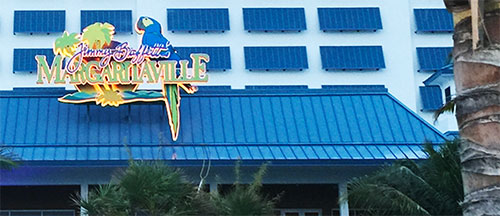
Wednesday, May 11, 2016: Back in the drink! — If you get thrown off a horse, they say, get right back up in the saddle. That sounded like good advice after having missed those dives. I did not want to get in the habit of bowing out of dives for minor reasons.
So I hoped that all would go well the next time out. And it did. The water looked much calmer from the balcony of our place, and once in the boat and on open water, the waves were indeed much smaller. The day's dives started with the 170-foot Sea Emperor, which despite its impressive name is really a hopper barge. She was sunk with 1,600 tons of concrete drainage culverts on board, a good part of which ended up laying next to the barge because she flipped over as she went down.
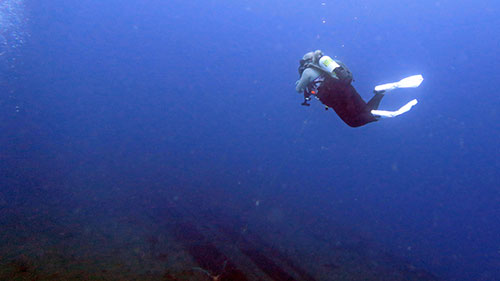
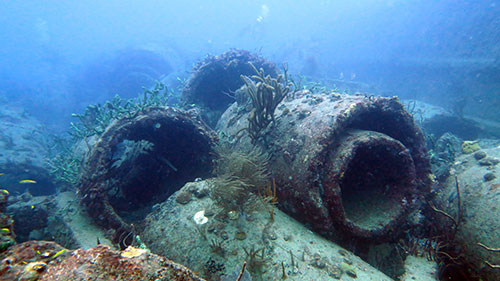
There wasn't much current going down and the visibility was quite good. The spilled culverts made for a great habitat for all sorts of life and exploring it was interesting. And the wreck's depth at 75 feet meant a longer dive.
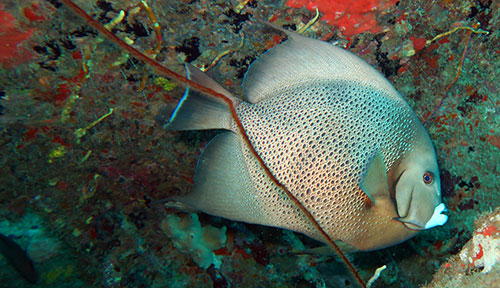
Despite the barge being upside down, it was easy to get inside and dive in and between the compartments, many of them teeming with fish. Every chamber had access to the open water, so there was plenty of light and no chance to get lost.
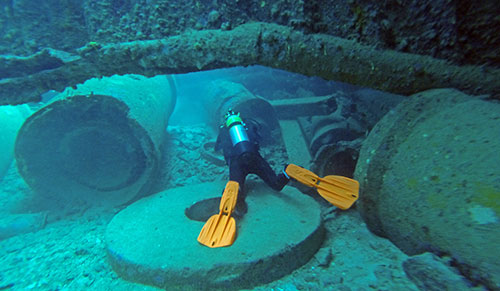
While current is a challenge when visiting wrecks it's also what makes drift dives possible. There the idea is to have the current take you along for a ride. It's a great way to relax and just watch the scenery go by. We had been told that the South Florida reefs were modest and nothing worth writing home about, but that turned out to be quite wrong.
The reef area at about 60 feet that we drifted over for an hour was interesting and quite impressive. We saw hundreds of barrel sponges and all sorts of life in an endless variety of slopes and ridges with the occasional overhang. There weren't walls or the kind of massive coral heads like you see, for example, in Roatan, but it was better and larger than the reefs in many other dive areas with a much greater reputation for good reef diving than Pompano Beach.
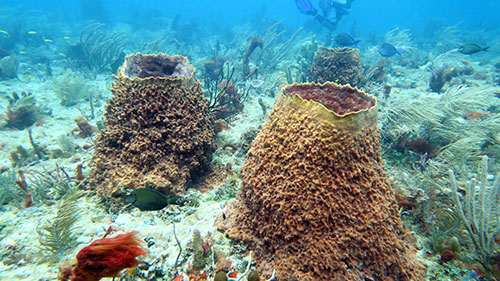
The barrel sponges weren't quite as large as we've seen elsewhere, but what they lacked in size they made up in numbers. Spiny lobsters found holes to live in and defend, as did a good number of moray eels. We didn't see too many lion fish, which is a good thing for the native critter population. A green turtle didn't mind our visit and let us get close for some pictures and video.
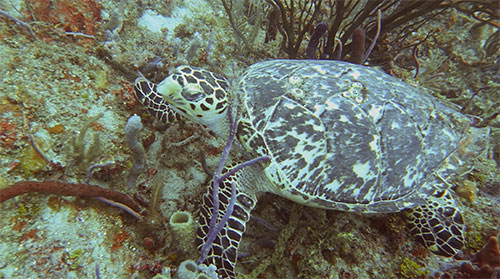
Even after a good many dives in my life, I am still amazed how conditions affect everything. Rough sea can be nauseating and even keep you from diving. The sun adds light underwater and makes you feel warmer, whereas an overcast day can make dives feel cold and gloomy. Current can be a total pain as getting down to and back up from an anchor line dive becomes all about getting there and back again instead of enjoying the actual dive. Waves can make getting back on the boat stressful and even dangerous. Being able to spread out on a boat is so much more comfortable than a sold-out trip. Then there are the ears and sinuses that may or may not cooperate no matter how much experience you have equalizing the pressure in your ears. And masks that may or may not fog up. Being cold can ruin even a great dive because it becomes all about the cold and somehow staying as warm as possible.
A few words about the importance of the right tanks. One of the benefits of driving is that we could bring along our own tanks, two steel 100s for me and two steel 80s for Carol. That's different from the ubiquitous aluminum 80 tanks used by almost all resorts, liveaboards, and dive operations. Steel is less buoyant than aluminum and therefore requires carrying less weight. I also liked having the 100 cubic foot steel tank because, despite being the same external size as an aluminum 80, the extra 25% of air means one is hardly ever low on standard dives.
Thursday, May 12, 2016: Wrecks aplenty — While San Diego's "Wreck Alley" is famous for its ship wreck diving, in terms of the sheer numbers it is dwarfed by what's available off Pompano Beach and neighboring communities in Florida. 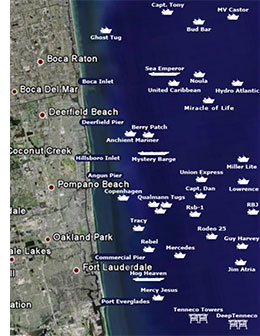 There are literally dozens of wrecks laying off the coast here. They range in length between under 100 feet all the way to over 400 (the Lowrance), and sit in waters as shallow as a few dozen feet all the way to 250+ feet for technical diving. Most, but not all, were sunk as artificial reefs, and at that they succeeded admirably.
There are literally dozens of wrecks laying off the coast here. They range in length between under 100 feet all the way to over 400 (the Lowrance), and sit in waters as shallow as a few dozen feet all the way to 250+ feet for technical diving. Most, but not all, were sunk as artificial reefs, and at that they succeeded admirably.
And while the waters off San Diego are perennially cold, the South Florida seas are warm and pleasant. We saw 78-82 degrees in early May. Current can be an issue, as can be visibility, but overall, if there's a wreck alley, South Florida certainly has a strong claim.
While few divers will list Pompano Beach as one of their preferred diving locations, that's just because the diving here is comparatively little known. We had expected some easy, shallow diving to brush up skills. Instead, our first two dives were to 110+ foot wrecks, one right after the other. The next day another big, deep wreck with current so strong that it ranked among the top ten most challenging dives in my 350 grand total. So this is serious, interesting diving here.
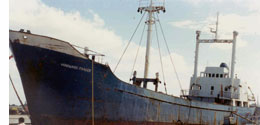 But to get back to our adventures, this day started off with a dive down to the wreck of the 215-foot Dutch freighter Rodeo-25, sunk in 1990 and sitting in 130 feet of water on a sandy bottom. There was no current going down or back up, and 100-foot visibility made for an awesome dive. It's always great to see large parts of a wreck and not just what's right before your nose. Light and visibility help to convey a sense of the true size of a wreck.
But to get back to our adventures, this day started off with a dive down to the wreck of the 215-foot Dutch freighter Rodeo-25, sunk in 1990 and sitting in 130 feet of water on a sandy bottom. There was no current going down or back up, and 100-foot visibility made for an awesome dive. It's always great to see large parts of a wreck and not just what's right before your nose. Light and visibility help to convey a sense of the true size of a wreck.
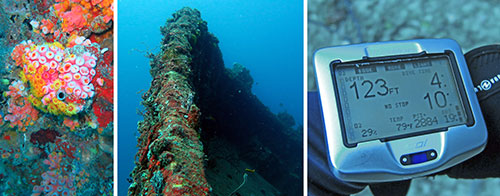
Here, again, we ran smack into the limitation of allowable bottom time. The dive shop had thoughtfully filled our tanks with just 29% Nitrox instead of 32%, thus increasing maximum depth from 111 feet to 126 feet, just enough for me to touch the sand next to the wreck. Swimming around the wreck still meant to be at a depth of 100 feet, quickly munching up remaining bottom time. The rear part of the wreck with the bridge and masts was much taller and made for a shallower dive level, but since the anchor line was attached to the lower bow all divers had to return there. I stayed fairly high on my return from the masts to the bow and anchor line, and still got down to just one minute of no-decompression time on my computer. Most others had certainly gone into deco time.
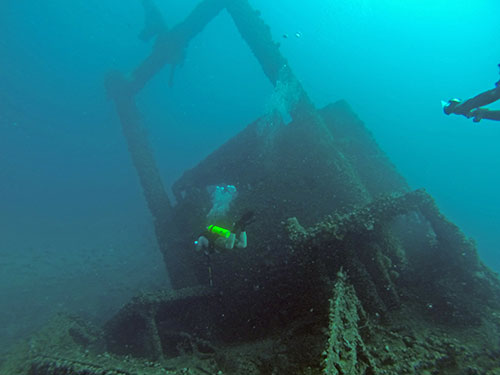
Given the depth of this first dive, we made the second dive a nice, pleasant drift over the reef, with lobsters, lion fish, morays, a scorpion fish and tons of other colorful life.
The rest of the day was quite eventful. We had dinner with old acquaintances, a couple that we had met a few years ago on a liveaboard trip around Turks and Caicos. And our friends found, much to their dismay, that the battery of their truck was dead. That normally just requires a jump, but if the keys to the truck are inside the vehicle and its keypad lock has no power, it's a different matter altogether. Especially when it's a 7-liter diesel in a parking garage. The cause was obvious: an ice chest had remained connected and drained both batteries of the big vehicle. All attempts to get into the vehicle to at least pop the hood failed. But googling revealed a way to restore power and thus open the truck. And AllState roadside assistance arrived in the form of a dude with a Rastaman do in a Volkswagen. He got the job of jumping the big diesel done with two booster batteries helping the Volkswagen.
Friday, May 13, 2016: Four on the floor, and a hammer — Generally it takes a few days to become familiar with a dive operation. That's what happened to us on this South Florida adventure with the great folks at the Pompano Dive Center. Once we had become friends with all of them and knew how it all worked, who does what, and what goes where, it was already the last day of diving for the trip. But what a last day it turned out to be.
Our friends had left that morning to spend a day with family on their way back home, and we were the only divers on board. Just us, the captain, and two divemasters. So the crew outnumbered us. That can't be very profitable for a charter operation, and it showed again that apparently few divers know how great the diving in the Pompano Beach area is.
The water was all but flat, the sun was out, and we started the day with a return to the Captain Dan. Going back to a wreck for a more leisurely examination is always a treat. The conditions weren't the greatest but we got to do some of the penetrations we had skipped on the earlier dive. After a quarter of a century down there, the Dan is still almost completely intact, but covered with all sorts of small growth and it looks a bit muddy. If there's enough light or one uses a flash, though, colors pop up and the old wreck beautifully comes to life.
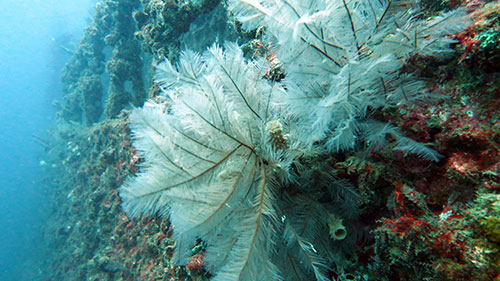
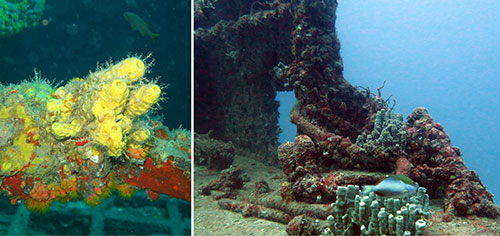
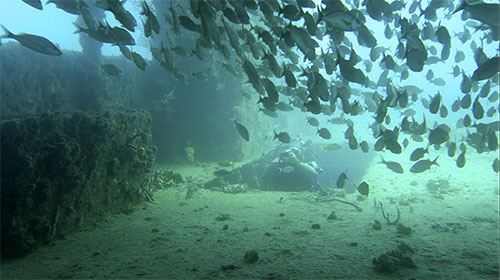
When the Pompano Beach dive boats don't go out with divers, they are engaged in a shark tagging project. Apparently that's a government funded attempt at learning more about the types, presence, and migration paths of sharks in the area. Personally I had a hard time imagining how the same dive boats we used also served as platforms to hook sharks, get them onboard, examine and tag them, and then let them go again.
After the deep Captain Dan, we decided on a leisurely drift dive to cap the morning. The current almost always runs south to north off the Florida coast, and since the wreck was south of the inlet the dive boat uses to get home to its port, the drift dive was on the way. They called this particular one "Razzle Dazzle," and it certainly lived up to its name. On that dive especially.
That's because just minutes into the dive along the 60 foot deep reef I looked to my left and found myself right next to a Hammerhead shark. That is definitely not a common occurrence, and certainly not on a drift dive near Pompano Beach, South Florida. Hammers usually swim in schools and they are shy, hardly ever getting close to divers. This one was alone and was no more than a few feet away from me.
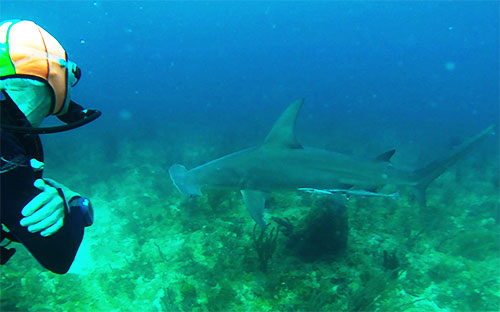
The whole encounter lasted no more than a few seconds from when I first saw the sizable Hammer (it was larger than it looks in the picture below, due to perspective) and when it disappeared again behind me. Had I been surprised this way by a barking dog or a larger wild animal on land, I'd have experienced the familiar rush of adrenaline that instantly puts the human body on alert and in code orange condition. Yet, I felt none of that other than a "wow, this is so cool!" sensation.
Carol was right next to me and when I alerted her to the shark had the presence of mind to quickly raise her GoPro and takes pictures. Amazingly, she managed to capture a great shot. That served as proof that it had actually happened. She later said she was surprised about my calm reaction, as Hammerheads apparently can be pretty nasty.
In a way, however, it was no different from dives off West Caicos in the Caribbean where we'd been surrounded by reef sharks: a sense of wonder and excitement of seeing those magnificent creatures. Somehow fear never entered the mind. Maybe it's because unlike on land where you can instantly plan defensive or evasive action, in the water what you can do is so very limited that all a human diver can do is watch.
This was supposed to be our last dive of the trip, but Carol talked me into signing up for the afternoon dives as well. Only three had signed up for that and the boat needed a minimum of four to go, so it seemed the right thing to do, especially since we had missed those dives earlier in the week.
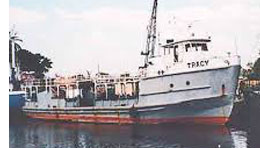 Of our fellow divers on that last trip out to sea were a father/daughter team with the girl being in her teens and on her very first dive after certification in a lake. Thinking back of my own first actual dive, going out on a dive boat for a 45 minute ride on the open ocean and then dive a 80-foot wreck down an anchor line seemed quite a challenge.
Of our fellow divers on that last trip out to sea were a father/daughter team with the girl being in her teens and on her very first dive after certification in a lake. Thinking back of my own first actual dive, going out on a dive boat for a 45 minute ride on the open ocean and then dive a 80-foot wreck down an anchor line seemed quite a challenge.
The wreck of the Tracey sat on sand at 70-80 feet in mediocre visibility, but it certainly was a treat. Under a large metal canopy were many thousands of fish. They love that kind of setting. There was also ample penetration and we explored some of that.
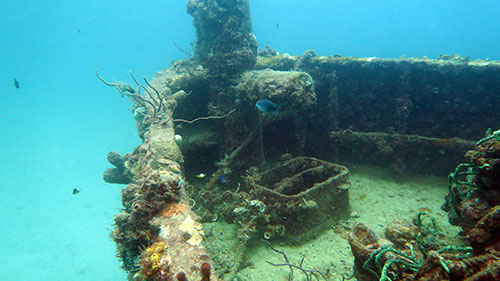
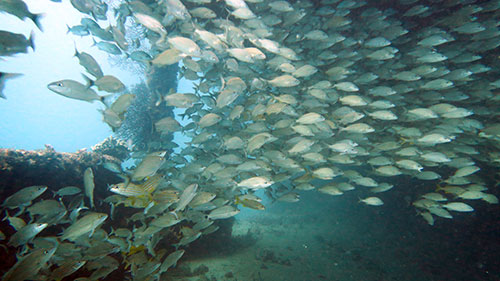
The sand around the Tracey was also favored by stingrays. We spotted one who let us get quite close before he took off, whirling up sand in the process.
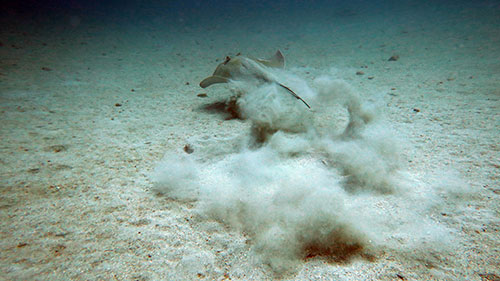
Then I discovered markers away from the wreck and decided to follow those, as there were two other wrecks nearby. It was perhaps a 200 foot swim until another wreck suddenly loomed before us, likely the 95 foot long Jay Scutti, and so we got two wrecks in one. And an encounter with a giant grouper to boot.
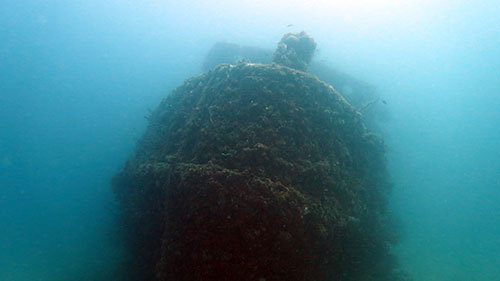
There was not enough time to explore the wreck of the Jay Scutti as the third diver that had come along on my exploration was on a smaller tank and his air was getting low. So we returned to the Tracey and went up the line.
And, oh, before we departed for the second wreck, we saw the young lady diver happily swimming around the wreck! Good for her! She did just fine, too, on the drift dive that followed, having decent air consumption and apparently no fear. Her arms and legs were busy, as is almost always the case with new divers, but that'll change. She did not notice that a nurse shark made an appearance behind her. We told her later and she regretted not having seen it.
Saturday, May 14, 2016: Drive home: No lines, no hassles, no TSA — All dive trips begin and end with, well, the trip. This time that meant packing the car and then a long 830 mile drive each way. That took 13 hours from door to door. Which was actually more than most of the international dive trips we've done.
But I was reminded again how driving has so many advantages. While cramming gear and necessities into whatever the airlines allow is always a huge hassle,you simply put into the car whatever you think you may need. On this trip back home we had four big scuba tanks, two large scuba gear bags, clothing and toiletries, towels, food, camera bags, and assorted odds and ends. Far, far more than one could ever take on a plane.
And it's economical. The Prius needed just one fuel stop for the 830 miles to get from home to our destination. It used a grand total of 17 gallons of gasoline, which at an average of just over $2/gallon cost just $34 one way. Plus a great lunch at Joe's barbecue somewhere in the southern part of Georgia.
There is also no ridiculously expensive airport parking, no standing in long lines, no TSA hassles, no waiting for the plane, no boarding, no tiny rock-hard seats, no endless delays, no rush to the baggage claim, no long line at immigration, no hassles at customs, no hustlers, no surly gate agents, no cab or bus to the final destination. And when you're there, you have a car to go places, anytime, anywhere.
Right now I don't feel I ever want to set foot in an airplane again. Or have my luggage and my body searched one more time.
Posted by conradb212 at 1:28 PM
July 15, 2014
Saba and St. Kitts, May 30 to June 7, 2014
It was a deal we couldn't resist, and after the unfavorable weather condition we had encountered on the same itinerary in 2010, we had intended to go back and do this trip over anyway. Saba and St. Kitts in the Leeward islands of the outer Caribbean, onboard Explorer Ventures' Caribbean Explorer II. Only this time we'd do the trip in reverse order, start in Saint Maarten and leave from St. Kitts.
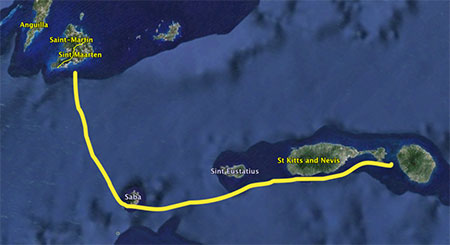
Getting there means a long trip from California. This time we took a shuttle flight to Los Angeles, a red-eye to Newark, and then it was another four-plus hour stretch to St. Maarten. Packing for a liveaboard dive trip is always a challenge because it's hard to anticipate what you'll need and what should be left behind. Having been on the same boat before made it somewhat easier. One doesn't need much clothing on a liveaboard. There is no dressing up for dinners or nights on the town. But if you forget something, there's little shopping to cover omissions.
I wasn't sure what wetsuit to bring. Last time we did this trip was in late summer, with water temperatures a steady 86 degrees. That meant even a 3mil wetsuit was too much and we did many dives in just bathing suits. This time the boat company predicted around 80 degrees, and divers know the big difference just six degrees can make. So I brought along my 5mil wetsuit. It's bulkier and I might get hot, but that's better than feeling cold and clammy on dives.
Saturday, June 1, 2014 Saint Maarten — We arrived at the modern St. Maarten airport shortly before noon on Saturday. The customs official determined that, contrary to the way we had filled out the forms, we weren’t actually going to stay in St. Maarten and it was a transfer. Still, immigration was quick, we got our luggage, and found a cab driver with a Caribbean Explorer sign waiting for us outside the airport. The taxi ride to the marina was longer than expected, winding through little towns and up and down the mountainous island which is half Dutch Saint Maarten and half French St. Martin. For that we were charged ten dollars per person and I gave the friendly cabby another five.

The Caribbean Explorer II was moored in Bobby's Marina and we were greeted by some of the crew. We couldn't board yet because the rooms weren’t quite ready, and so we decided to explore St. Maarten for an hour or two, until the 3pm boarding time. It was cloudy, hot, and stiflingly humid. We meandered around the boardwalk with its palm trees, made our way through the narrow little alleys with their endless souvenir shops and stands with insistingly peddling locals. That was in stark contrast to tourists perusing Cartier fashions and Rolex watches in luxurious designer stores. St. Maarten felt a bit seedier than we remembered, but maybe it was the lack of sleep and the heat and humidity. We should have had a drink and some local fare in one of the many tropical looking bars. But, unable to make a decision, we went with Subway sandwiches instead and ate them outdoors in the heat.
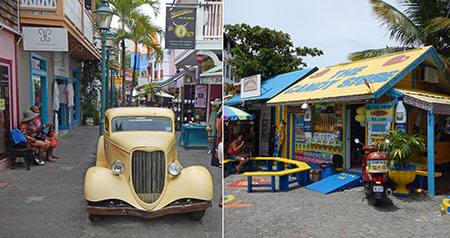
We were back at the boat around three, set up our dive gear, and got acquainted with the staff. This time we had stateroom #3 on the main deck, which was far more convenient than the downstairs cabin in the front of the boat we had had on our first trip on the CEX II. Our new accommodations had a queen bed at the bottom and a twin bunk on top of it. There was large storage under the bed and we could also use the upper bunk to store more of our stuff. The room was a bit smaller than the cabin we'd had on the lower deck, but it was nice enough. There was a sink in the cabin, and we had a separate shower with a toilet. There was only one power outlet, though, and so I was glad we had brought a 7-port USB charger and an outlet multiplier. Unlike on our prior trip, the A/C definitely wasn't a problem this time and the cabin was, and stayed, almost icy cold. Last time it had been humid and too warm.
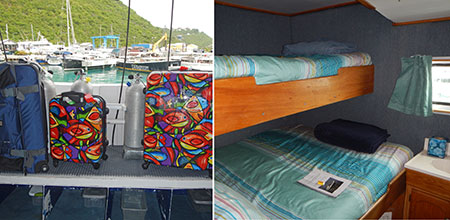
It is always interesting to meet the crew. This time it consisted of just five. There was the charming and very personable purser/divemaster Maria who had worked on the Honduran island of Utila and also on liveaboards; divemaster Martin, a young man from Belgium; engineer Charles, a friendly and helpful ex-Navy man; cook Jane and captain Ian, both of whom had been on the boat last time. A crew of five is marginal and apparently a couple of staffers had canceled or were unaccounted for. As it turned out, the skeleton crew worked hard and never missed a beat. Purser Maria also was divemaster and waitstaff, Ian helped with serving, while engineer Charles helped on the dive deck, and Martin was divemaster and managed the dive deck. It can be done with five staff for 17 guests, but it cannot be easy.

We’d barely finished settling in (and received an explanation of the room emergency and safety systems by engineer Charles) when it was already time for dinner. Cook Jane prepared deliciously tasty steaks on the barbecue on the upper deck, accompanied by asparagus, cauliflower, potatoes and salad. For dessert there was vanilla ice cream with rum cake and fruit. You never go hungry on a liveaboard, and the food is good and plenty. You never go thirsty either. The CEX II has a well stocked bar with all sorts of liquor, red and white wine, plenty of beer, and also a soda dispenser system. In addition, of course, to juices, numerous teas, milk and water.
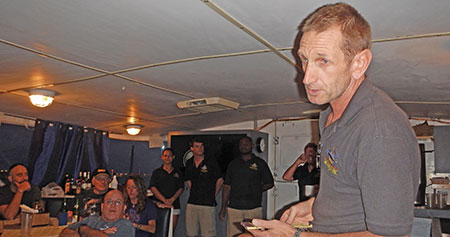
After dinner, Captain Ian introduced the crew and did an overview of the ship and its operation. At 8pm the boat left St. Maarten for the island of Saba. The captain had warned of a rough crossing, but it wasn't all that bad. Carol and I went to bed at 8:30 and slept great all through the night.
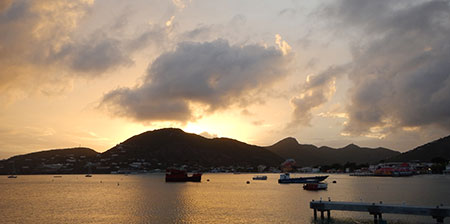
Sunday, June 2, 2014 Saba — I woke up around six o'clock on Sunday morning, and saw the boat was anchored close to the almost vertical rock wall of Saba. There was a slight breeze, the temperature was pleasant, and actually welcome after the rather cold cabin. I went upstair, got coffee from the boat’s new machine that upon pushing a button dispenses excellent coffee and even espresso. Breakfast began at 7, with eggs and sausage to order, and there were also bagels, rolls, cereals, yogurts, juices, and more.
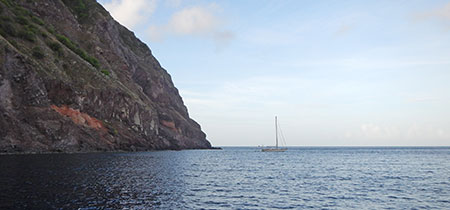
At 7:45 the captain did a general briefing on the rules of diving on the CEX II. 130 feet maximum depth for those on air, 110 feet for those on nitrox (which was the majority of the guests). Maximum dive time 70 minutes, no gloves, no touching, always diving with a buddy. No need to change tanks after every dive; the crew fills them with the air whips installed on the dive deck. There is a dive briefing before every dive, and we’d be alerted to it by the blowing of the conch (which sounds like a fog horn).
Then divemaster Martin blew the conch and did the first dive briefing of the trip. The first dive was at Ladder Labyrinth a brief distance off the rocky slope of the island. The water seemed rather clear — a huge difference from our last trip where we had to descend the anchor line through 30 feet of murk. We jumped in the water and clearly saw the bottom from the surface.
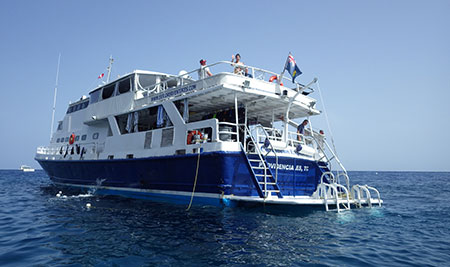
The water temperature was a nice 81 degrees. I was the only one on the boat who wore a 5mil wetsuit and wondered if perhaps that was too much, but at least on this first dive it felt just about right. I had started with 14 pounds of weight, and that did not seem quite enough, especially towards the end of the dive. For some reason I always need more weight than one would expect. Right underneath the boat there were a few large tarpon that seemed totally undisturbed by us divers.
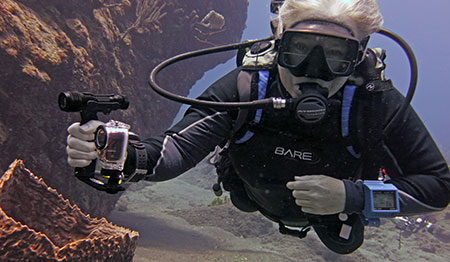
The dive itself was very nice. We saw an attractive mix of coral heads, coral islands, and coral fingers through which we meandered at depths ranging from 40 to 80 feet. I had a brand-new mask and, despite extensive cleaning beforehand, it remained fogged up during the entire dive, impairing vision. I should have known better. We saw a pair of goofy-looking and very tame large puffers, a few tiny juvenile spotted drums, and the usual assembly of Caribbean aquatic life, though nothing exceptional. It turned out to be an 80-foot one-hour dive.
The Caribbean Explorer II has two weights hanging off its stern at 15 feet. These can be used to hold on during the mandatory three-minute safety stops. I did that, and was treated to a nice ride as the boat drifted around its mooring line.
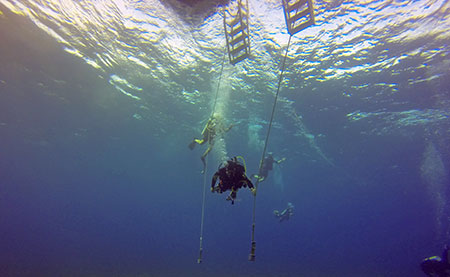
Getting back on the boat means grabbing one of the two very sturdy ladders onto the lower dive deck, handing the waiting divemaster fins and camera, negotiating the few steps  first onto the dive platform and then the dive deck, giving the captain your maximum depth and remaining air pressure, then taking off the gear. Particularly nice are the two warm shower heads on the dive deck. There's nothing like a hot shower after a dive, to get the salt off and warm up. And since you work up an appetite when diving, Jane had baked banana bread which made for a tasty snack between dives.
first onto the dive platform and then the dive deck, giving the captain your maximum depth and remaining air pressure, then taking off the gear. Particularly nice are the two warm shower heads on the dive deck. There's nothing like a hot shower after a dive, to get the salt off and warm up. And since you work up an appetite when diving, Jane had baked banana bread which made for a tasty snack between dives.
I noticed that, while last time we hadn't seen another boat the whole trip, this time there were several smaller sail boats anchored along the coast of Saba.
The second dive was again at the Ladder Labyrinth dive site. In her briefing, divemaster Maria told us of the presence of hot sand underwater, thanks to Saba’s volcanic origin.
Once in the water, she set a nice slow pace, there was plenty of sun, great visibility, and a balmy 82 degrees. We mostly stayed shallow, leisurely diving around all those gorgeous coral heads. Maria showed us the strips of warm sand that you could tell by their orange color. The sand isn’t really hot, but nice and warm. It’s a very nice dive site, and so close to the shore that I wished we could have approached the rock face of the island.
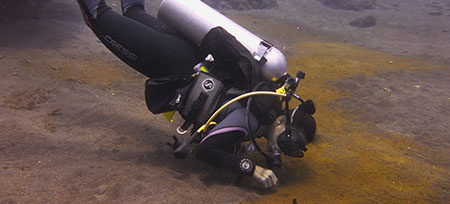
At home, breakfast and snacks would leave me plenty filled up till dinner, but when diving you’re always really looking forward to lunch. Steak meatballs, salad, a tasty curry soup, and tortellini and other pasta really hit the spot.
For the third dive the captain moved the boat a short distance to the “tent†sites, so named after a tent-like formation on top of the rocks on the surface. For this dive, the mooring line was anchored on top of an underwater wall, but the CEX II was floating over deep water, and so we had to descend along the mooring line.
Despite having added two pounds of weight, I still had a hard time getting down, and once I was, my Canon G15 camera acted up. That aggravated me to an extent where I missed enjoying part of the dive. The wall reminded of the Roatan walls, with beautiful barrel sponges and lots of the bright yellow sponges that are my favorites. We even saw a reef shark in the distance. At the end of the Tent Wall site the wall gives way to the Tent Reef site, and so we turned around and swam back on top of the wall. Unfortunately now against a rather strong current that necessitated ascending along the mooring line again. My ears acted up a bit, too, probably going back to the problem descending.
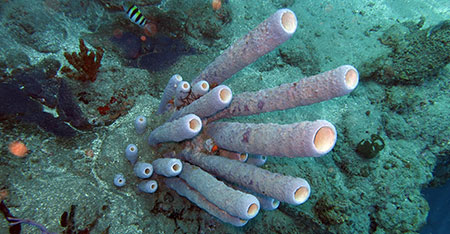
On the boat, a bowl full of warm chicken taquito flutes awaited us and made me forget the hassle with the camera.
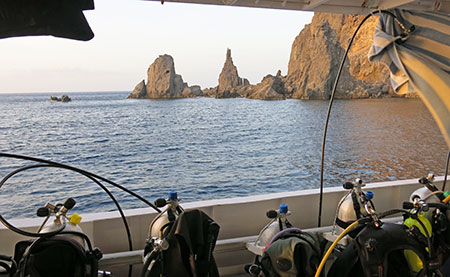
Then it was time for the fourth dive of the day. Torrens Point had been a bust on our last visit. Visibility had been virtually nil and we hadn’t see anything and quickly came back up. This time the site was gorgeous. The area is 30-45 feet of mixed sand, coral heads, coral fingers, with lots of life of all sorts. We did see a number of conch and other shells that some irresponsible divers had harvested and discarded, quite illegally as we were diving in Saba’s marine park. We took pictures of the heinous crime, both stills and video. Other than that, it was a pleasant leisurely dive with nice light, though it was getting darkish towards the end of the dive. I had taken along a GoPro 3 with dual LiquidImage lights and BackScatter filters, and experimented with the 30 to 50 feet filter.
For dinner, Jane served spinach-filled chicken breasts, sweet potatos, broccoli and salad, and then topped it off with a date-cake and vanilla ice cream.
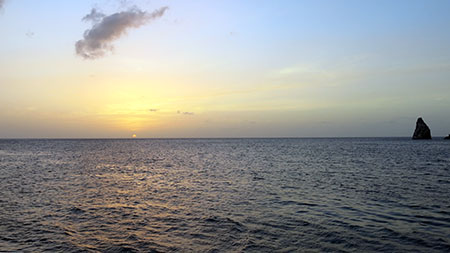
We skipped the night dive, though it probably would have been wonderful in clear water at Torrens Point. A school of very large tarpons were circling the ship, attracted by the light.
Gazing at the scenery from the upper deck and marveling at the good fortune of being on that wonderful boat in that wonderful place of the world, I mentally contemplated a few observations:
Last time we'd been hot all week and never wore any long shirt or shammy or anything warm. This time, with somewhat cooler weather and the strong A/C in the rooms, there was almost a rush to the ship's store where they sold hoodies and chammyz. So always be prepared. You simply never know beforehand what you’ll encounter temperaturewise
Second, while the much smaller cameras we use today aren't anywhere near as bulky as older gear, they come with so many cables, batteries, chargers, filters and other add-ons and gizmos that it quickly becomes overwhelming. With one camera it's okay, but with multiple ones it can become a nightmare to find and organize everything. What seems like manageable neatly spread out on the living room floor becomes a flood of things to keep track of on a boat.
Third, things that you'd never think would break will. Like my toothbrush. It snapped straight in half. That never happened to me before. Then again, I also had a pair of reader glasses fall apart during a major presentation I gave a few years ago in Stockholm. Another thing that unexpectedly broke was the band of my Uwatec SOL dive computer. I didn't expect that either.
And, of course, I did forget something -- the charger for my Nikon AW110 camera.
I also learned a new trick. To get the wetsuit on more easily, wet your arms and then put some soap or shampoo on them. That way they slither right in, well almost. Fortunately, the CEX II had a soap dispenser right on the dive deck.
Mooring lines often have all sorts of growth on them, especially if they've been in the water for a long time. Touching them is never a good idea, but it cannot be avoided in poor diving conditions. So even if gloves are not allowed, I'd insist on wearing a thin pair to keep fingers and hands from getting stung and infected. Just take them off once you've reached bottom.
Monday, June 3, 2014 Saba — I woke up Monday morning at 6am (which was just 3AM California time!), seeing the island of Saba through our cabin window. I had slept great, as always on a boat. I had some coffee, perused the massive rock face of Saba, and took pictures of the old custom house and the stairs leading up to it. There’d been a time when this was the only way to enter Saba, and anything that was brought ashore had to go up those steps and needed clearing at the custom house. We’d learn more about that later.
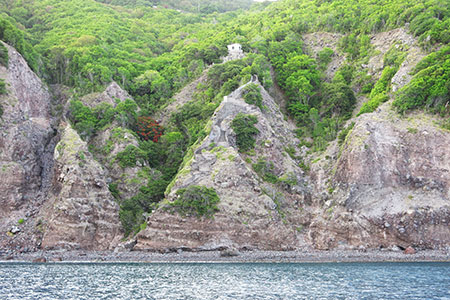
Our two morning dives at Tedran Wall, a site we hadn’t been before. Tedran stands for Ted and Randy, the divers who had discovered the site. It was a fairly deep drop to the top of the wall at 70 feet and so most of us went down the mooring line the first time. The wall itself was spectacular, with dramatic scenery in very clear water. We saw very little damage, large sponges and tons of other vegetation, including a great deal of that spindly black growth that was very pretty. I thought it was coral, but probably not. Above the wall were steeply sloping chutes that in some areas extended into the wall. There were large, beautiful sand dollars, Carol saw rays, and the only bad thing was that the dive was so deep that we ran a bit short on air (not Carol, of course, she surfaced with half her tank), and so started ascend the line at 35 minutes or so.
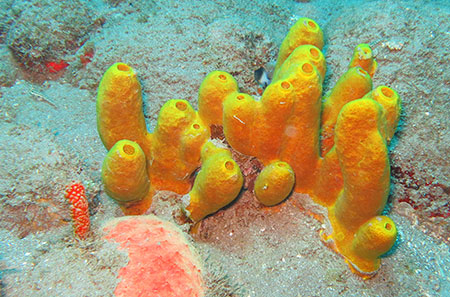
The second dive at Tedran was not quite as clear and current began to build. So instead of cruising along the wall we stayed on top of the reef and explored all the sand chutes and coral heads.
Between dives, Jane surprised us with delicious fluffy meringue coconut cookies. There was enough time to enjoy them as there are fairly long intervals between the dives on the CEX II, long enough to take off the suit, dry off and recover.
Two things happened that morning. One of the divers had a pony bottle since he dove solo, and the bottle and regulator attached to it apparently came loose and fell off into the abyss when he jumped in. The pony bottle was the ship's and neither Maria who made a recovery attempt, nor anyone else on the second dive at the site found it.
Another diver, 73-year-old Maurice who dove air, disregarded his computer's deco order and so the computer locked up on him. He was not allowed to dive for 24 hours, until the computer said it was okay.
 For lunch we had chicken Fajitas with giant tortillas (and yes, I am reporting on all meals to present a picture of what the culinary experience is on a diveboat like the CEX II). The captain informed us that he'd take the boat up to Diamond Rock to see what the conditions were for diving. He also told the story of the Saba Custom House perched high up in the rocks, with 300 steps steeply leading up to it, with most of the steps still there and visible from the boat. Until the 1950s, Ian said, this was the only way to get on Saba (which seems almost unlikely) and whatever goods and materials were brought to Saba had to go up those stairs for examination, registration and duty. I'd love to get on land and hike up those steps.
For lunch we had chicken Fajitas with giant tortillas (and yes, I am reporting on all meals to present a picture of what the culinary experience is on a diveboat like the CEX II). The captain informed us that he'd take the boat up to Diamond Rock to see what the conditions were for diving. He also told the story of the Saba Custom House perched high up in the rocks, with 300 steps steeply leading up to it, with most of the steps still there and visible from the boat. Until the 1950s, Ian said, this was the only way to get on Saba (which seems almost unlikely) and whatever goods and materials were brought to Saba had to go up those stairs for examination, registration and duty. I'd love to get on land and hike up those steps.
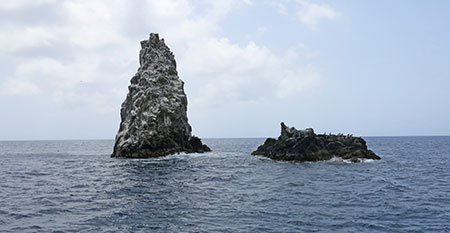
The first afternoon dive was indeed at Diamond Rock as the conditions turned out to be good. Diamond Rock, one of Saba's signature dives, is a twin volcanic spire emerging from flat sand at 75 feet, and rises above the surface by maybe another 75 feet. The boat moored close by the rock and the water was clear enough to just jump in and slowly descend towards the base of the spire. Once there, we began a one-turn clockwise rotation, encountering strong current in some spots and almost nothing in others. The view was spectacular, with gorgeous, large growth everywhere, myriad of aquarium fish doing their thing, and wonderfully clear water. We should have stayed in one of the calm spots as there was enough to see for hours.
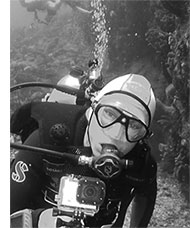 During the dive I kept hearing an unusual noise. It turned out that my tank valve was bubbling pretty badly, so much so that Carol was concerned about my air (and when I later looked at it on video it looked quite scary). It didn't go down alarmingly fast, though, and so I just kept a close eye on it. Unfortunately, the current was very strong right at the spot where we were supposed to head back for the boat, and so there was no staying and taking in the wondrous sights. The swim back through essentially blue water was hard, with current strong enough to make me pant.
During the dive I kept hearing an unusual noise. It turned out that my tank valve was bubbling pretty badly, so much so that Carol was concerned about my air (and when I later looked at it on video it looked quite scary). It didn't go down alarmingly fast, though, and so I just kept a close eye on it. Unfortunately, the current was very strong right at the spot where we were supposed to head back for the boat, and so there was no staying and taking in the wondrous sights. The swim back through essentially blue water was hard, with current strong enough to make me pant.
Since, for us, all dives were work dives where we evaluated underwater camera gear and equipment, Carol had taken along a LiquidImage EGO and I a GoPro Hero3 mounted on an orange stick with Backscatter’s “deep†filter.
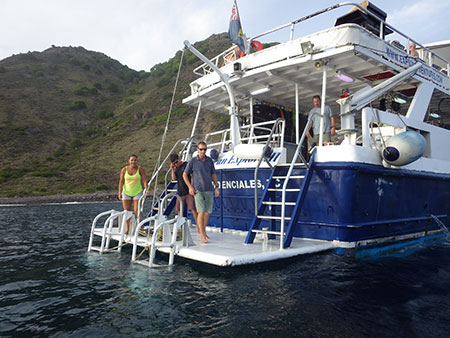
Carol and I skipped the second Diamond Rock dive and napped instead. I uploaded video and we examined the rather disappointing results. Underwater video and photography are never trivial.
Dinner was barbecue night with ribs!
One of the great things about liveaboards is that there aren't any bugs. These can thoroughly spoil any land-based vacation as we found out repeatedly in Roatan, Cozumel, Florida and other places. This time, however, Captain Ian warned of a “bug hour†where tiny non-biting but very pesky insects descend upon the ship — sometimes in great quantities — then die off an hour or two later. We didn't experience this last time we were on the CEX II, but as is the lights were dimmed and the plastic windows of the upper deck closed. The bugs arrived indeed, but it was no big deal.
I decided to finally do another night dive. I didn't really want to, but I felt I'd probably regret it later if I didn't do at least one night dive. I rarely feel comfortable on night dives and so didn't know what to expect. I took along three lights, the two Liquid Image torches on a base and pistol grip, and a backup light. Since Carol didn't come with, I followed dive master Maria closely.
It turned out to be a very nice experience. Slowly floating around the shallow (30-45 feet) coral reef with our lights was kind of a magical experience. I was nice and warm, thanks to the 5mil wetsuit at 82 degrees, and we saw all sorts of creatures that usually hide during the day. That included two nurse sharks and numerous spiny lobsters that were out of their daytime hiding holes. We had been warned that there was a chance there'd be sea wasps upon our return. If the boat spotted any, they'd lower a red light for us as a warning. We'd then have to use the octopus to blow up some air to make them go away for our ascent. Fortunately, there weren't any. And by the time I got back up on the boat, the bugs had all died off.
Another wonderful boat thing: hot chocolate, Baileys and Kahlua awaited us. After drying off and changing into regular clothes, Carol and I resorted upstairs for some popcorn and conversation with Jane. Jane’s from England, has always been a world traveler, and took up the nomadic Caribbean life a decade or so ago.
Tuesday, June 4, 2014 Saba — Woke up at 6AM again on Tuesday morning, to the same balmy temperatures and somewhat hazy ski — not cloudy, not overcast, just somewhat hazy. It was not as bad as that sounds because the relative lack of light in the morning was because the sun hides behind the massive bulk of Saba.
As I enjoyed a cup of coffee upstairs, the boat moved away from its mooring close to the island to a dive site about a mile away from shore. That's where Third Encounter is, a ledge at 90 feet or so, and beyond that the abyss. A shortish swim away from that is the Eye of the Needle, a skinny spire that rises up to within 90 feet of the surface, but which isn't visible from the ledge even under the best conditions. This is a Saba signature dive, but one that I ended up not making. I like deep dives, but on nitrox and having to swim to and from a peak that tops out at 90 feet below the surface means very little bottom time and lots of descending and ascending in the blue, neither of which appeals to me.
I did feel a bit like a wuss as everyone else, except Maurice whose dive computer was still locked, did go. A brave group we had, and that was not surprising as on this trip, there really weren't any inexperienced or marginal divers. So I concentrated on taking pictures of the boat and divers entering the water. Carol, as always, was the only one doing a forward roll.
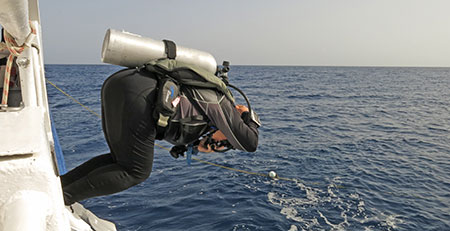
As it turned out, the divers reported excellent visibility and no current, so that the dive had been terrific. Carol went down to 110 feet and still brought back 1,600 psi on a 43 minute dive. She said you could almost see the spire from the ledge and that it had been marvelous. Oh well. Next time.
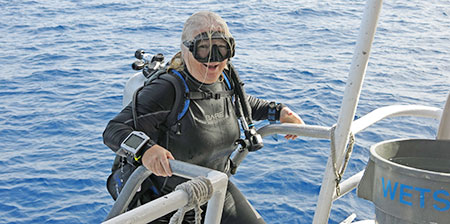
We then did two dives at Tent Reef. The site is a large area that includes everything from gorgeous shallow reeftops, to endless meandering swims between all the coralheads, to wall-like structures, to large expanses of garden eel sand. Part is luscious, colorful and undisturbed. Other parts are covered with silt. I wondered why the large difference between the silted and the clear areas. My air consumption was considerably better after the crew replaced the bubbling valve stem insert on my tank. No more bubbles.

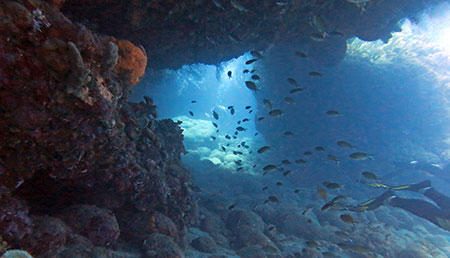
For lunch, cook Jane had prepared chicken and shrimp patties, burger style, with chips, salads, and condiments.
We cut the second Tent Reef dive a bit short in order to board the dinghy that brought us to shore for a tour of the island of Saba. That required two trips. All nine of us then piled into the same old microbus taxi driven by the same cab driver, Garvin, we’d had last time.
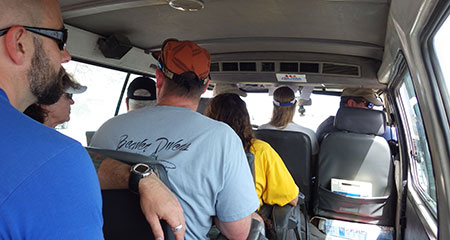
The road-that-could-not-be-built (according to a Dutch engineer back in the 1950s or so, supposedly) was fun, we saw the church again where a proper Dutch school marm prepared children for a religious ceremony.
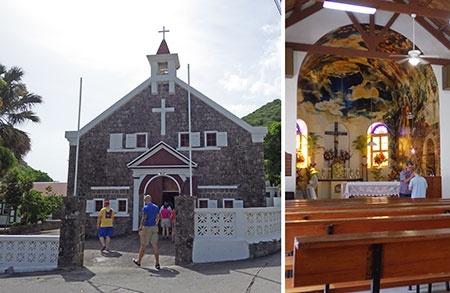
We visited the embroidery shop and bought a little piece of embroidery and some local liquor. Saba, supposedly, was once known as the Island of Women as the men were always away fishing. To pass the time they took up embroidery and developed it into an art form that lives on today.
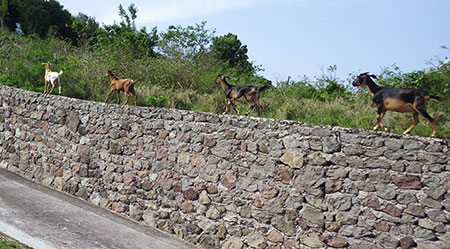
The van then took us up higher into the hills from where we could look down onto one of the small towns nestled into the valley. When viewed from the sea, it looks like Saba isn't inhabited at all. Wild goats are seemingly everywhere.
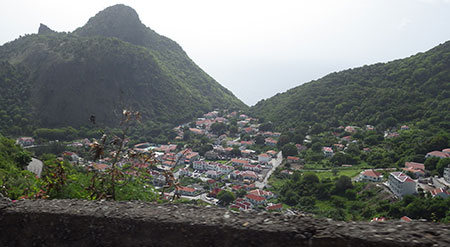
We then visited a glass shop with some wonderful artwork, then on to a place where we could overlook the airport with its impossibly short runway that stops at the cliff.
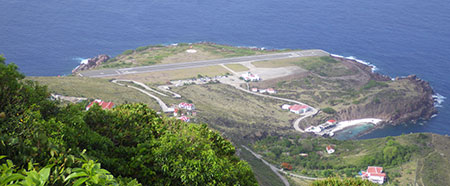
The cab then dropped most of us off to descend the old step trail down to the small town of Windwardside where we got drinks and shopped some more. The trail was steep, made of cement and stone and a bit on the slippery slide. It ran through lush tropical forest, thankfully devoid of insects. Good thing I had put on my sneakers. In town Carol shopped for some items, I bought some Pineapple Fantas in the little supermarket, and the others had beers at a bar.
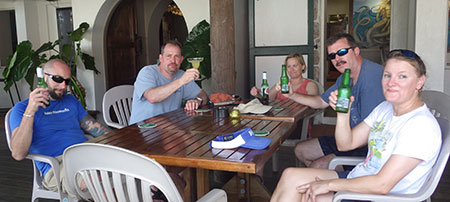
Overall, it felt like Saba had gone downhill a bit since we’d been there in 2010. I had expected the opposite as Saba was now no longer part of the Netherland Antilles but a direct part of the Kingdom of the Netherlands, but the island seems severely cash starved. The famed red roofs of Saba are as eye-catching as ever (though they're really just corrugated metal), but a lot of construction is unfinished or in need of maintenance. It often looks as if there had been an economic boom once the roads were completed in the 1950s and 1960s, but that not much has happened since. Which, of course, may be a good thing.
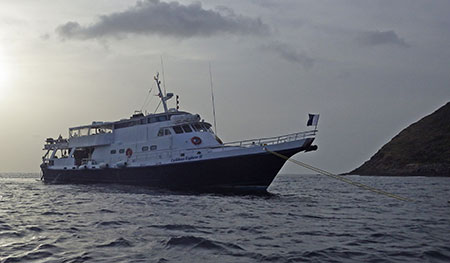
Upon return to the boat, which gave me a chance to shoot some pictures of the CEX II from the water as we approached, dinner was served, and it was another meal one would simply not expect on a relatively small dive boat: tender, tasty sirloin or fillet with mushroom sauce, rice, peas, carrots, and salad. For dessert there were hot brownies with ice cream. Then it was time for the three-hour passage to the island of St. Kitts, and taking assessment of our work so far
Our camera testing, we had to realize, had been dismal. We forgot the charger for one of them (the Nikon AW110), the Canon G15 had weird controls and white balance and is way off as often as on target, the two GoPro 3s produced very disappointing video even with filters, way, way worse than what one of the guests (Penny) managed with her Hero3+. I wondered if the newer GoPro Hero 3+ had a fundamentally better white balance than the older Hero 3.
Wednesday, June 4, 2014 St. Kitts — The crossing on Tuesday evening from Saba to St. Kitts took the expected three hours and went very smoothly. We went to sleep early, like 8:30 or so, and woke up Wednesday morning at St. Kitts, to a somewhat hazy sky (Garvin the cabbie had said the haziness was dust from the Sahara). Still, the island of St. Kitts looked lush and, unlike what one sees of Saba from the sea, St. Kitts shows quite a bevy of development, with lots of housing, many churches, roads, etc.
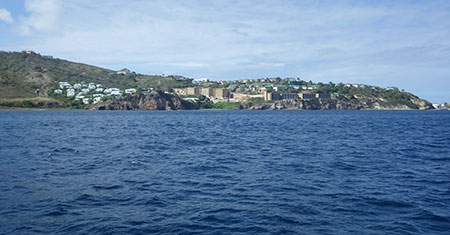
Our first dive was at “Paradise Reef†which — even this time — perhaps doesn't quite deserve its name. The site starts at a sandy slight slope at perhaps 40 feet with many small coral islands, then drops via large coral fingers down to another sandy area at 85 to 100 feet. The coral is often overgrown with some green leafy, meshy stuff that’s not very attractive. We saw a large lion fish, many fish traps (since St. Kitts is not a marine park), a couple of anchors and old timbers and ropes from St. Kitts vast maritime history, a few small southern stingrays, and plenty of little reef fish, plus a couple of large barracudas.
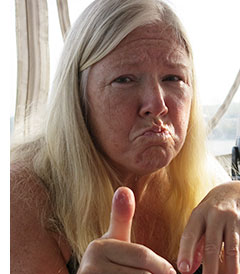 Carol's thumb had become all swollen from contact with fire coral from the mooring line at Tent Wall in Saba. My fingers ached a bit, too, from contact with those lines. It’s best to bring gloves whenever using those lines!
Carol's thumb had become all swollen from contact with fire coral from the mooring line at Tent Wall in Saba. My fingers ached a bit, too, from contact with those lines. It’s best to bring gloves whenever using those lines!
For lunch we had three different kinds of pizza, mango and melon, salad, and assorted beans.
I asked Maria why the good ship CEX II appeared to be listing to the right by perhaps four degrees and she said there were many theories about that. Four years ago I did not note any list. Carol said the captain had attributed it to a ballast distribution issue that needed fine-tuning.
The afternoon dives were close-by, at “Anchors Away.†Captain Ian said that was because when the English and French were battling it out, whoever was in the boats (the English and the French battled often) would yell "anchors away" when they saw the other party getting the cannons ready at Brimstone Fort. I am not sure if that was indeed the case, or if it was another of the captain’s straight-faced stories.
As is, the drop to “Anchors Away†was fairly large to the top of the reef, and from there it goes down to 75 or 80 through coral fingers until another large sand area. We didn't have much sun, so the site wasn't as attractive as it could be, but it also seemed a bit beaten up and covered with the mesh algae. There was considerable surge back and forth, and it seemed like most of the dive we were fighting against current, which became frustrating.
I did see two large lionfish, a reef shark, and perhaps the largest lobster I had ever seen, right on the reef top under the boat.
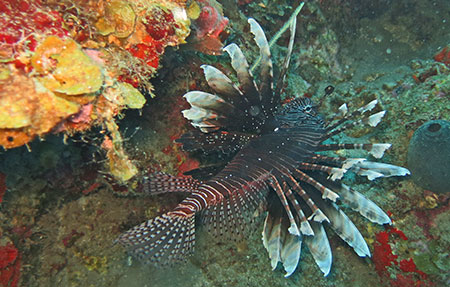
Back on the CEX II we found cheese and crackers as a snack, and, as usual, there was ample time to change batteries and upload video and pictures. Carol skipped the forth dive of the day, but I decided to go. On this second dive to Anchors Away we had much less current and surge and it turned out to be a nice, leisurely dive. I really like dive master Maria's pace.
Highlight of this dive was a standoff between a large lobster almost all the way out of its hole and three large lionfish facing the lobster. The lobster batted at them with his long antennae, and it wasn't quite sure what was going on. One does not usually see multiple lionfish in the open. But the lobster looked like much too large a prey for the lionfish.
Once back on the boat, we were treated to a gorgeous scenery with dramatic clouds on the horizon and you could see not only the northern end of St. Kitts but also the island of Statia, and even Saba, in the distance.
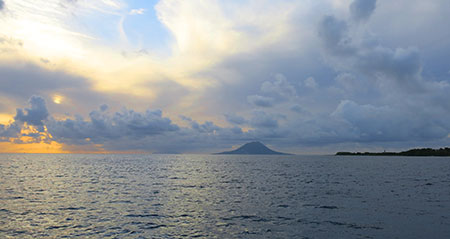
This evening those who ate seafood (which was everyone except Carol and myself) were treated to freshly caught fish that a fisherman from St. Kitts brought to the boat and cooked on the grill. I still often wonder how divers can eat fish (or catch lobsters) because watching those fish brings us so much pleasure and it seems inconceivable to eat them.
After dinner I went to the front of the boat where there were no lights and it was peaceful and dark. I wasn’t alone, though; there was Mike, who is 38, used to work for Lehman Brothers, and went to Japan for a long weekend last New Year's. He told me all about it. From the island we heard very loud preaching and music that went on for hours.
Thursday, June 5, 2014 St. Kitts — On Thursday morning there were dramatic clouds over the island of St. Kitts, and also over neighboring Statia in the distance. It rained a bit on and off, and the effect of it all was just wonderful.
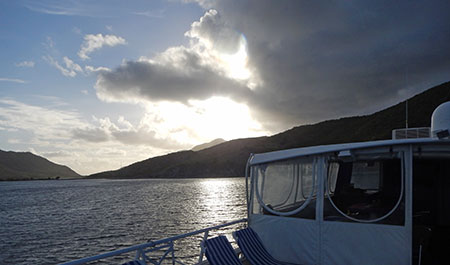
For diving, the captain moved the boat halfway up St. Kitts to an area called Old Road Bay where supposedly the first Europeans landed and settled. It received its name from one of the first roads built along the coastline. In more recent history the area had had quite a bit of fishing activity and there were many fish traps at the bottom, making diving inadvisable. There captain said there are far fewer traps now as the locals apparently moved them elsewhere.
To dive this site, we dropped to a sandy area at about 50 or 55 feet, from where we meandered through and above coral islands and sandy areas. The reefs were pristine, with just a bit of the green mesh algae. We saw a surprising number of morays, many of them free-swimming. There were also very tame large puffers that just sat there when we photographed them, and if we came too close they just slowly swam away. We had hoped to see some frogfish, but didn't find any.
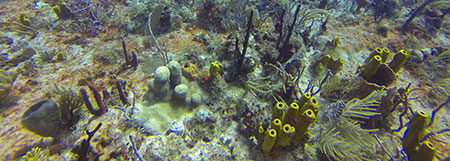
The boat needed to drop the anchor at Old Road Bay as there were no mooring lines. That means it swings around its anchor, making it difficult to locate its presence in low visibility. On the first dive we had clear water at the bottom and the boat was easy to find. We did the second dive at the same spot, but in much murkier conditions. We saw a giant turtle and, at the end — finally — a frog fish, and the boat was much harder to find in the reduced visibility. I had no idea where it was, but divemaster Maria listened for the sound of its engines and located it right away.
By and large, though, conditions play a far larger part in how much one enjoys a dive site than anything else. An unexceptional site in perfect conditions can be far more fulfilling to dive than a great site in bad conditions. You could also argue that ocean dive sites tend to be much the same in different parts of the world. The local fauna and sea life may change and vary a bit, but overall it's hard to differentiate between, say, a nice reef in Roatan from one off Providenciales, from one off St. Kitts or Saba. Same for walls. What sets them apart is the condition, variety, and the visibility and weather. Walls are different from the flat top of coral heads, of course, but what matters almost more is the depth. Closer to the surface there is more light, more sun, more color than down deeper. It's nice to occasionally go deep, but much of the attractive scenery is in shallower water. For that reason I prefer shallow reefs.
For lunch there was — surprise — another excellent meal: chicken kebabs, hummus, pita bread, feta cheese salad, peanut sauce, asparagus salad, and wild rice.


In the afternoon we dove the wreck of the Corinthian. We had visited it twice in 2010 and those had been enjoyable dives with very good visibility. I love wrecks and had looked forward to seeing the Corinthian again. Unfortunately, once we jumped in it was immediately clear that the conditions were nowhere near as good this time. The water was murky and we had to go down the mooring line. Once the wreck came into view it cleared up some, but the water still looked like we were in a snow storm. I began shooting video of the wreck, or so I thought, as the GoPro had somehow set itself to photography instead of video and I had wasted half a pass around the wreck. I tried again but by now the divemaster was already heading away from the wreck and disappearing in the snow storm. That's when I noticed that the LCD screen of the camera had gone out, with just a faint red light showing. I tried to turn it off but it did not respond at all and just kept recording.

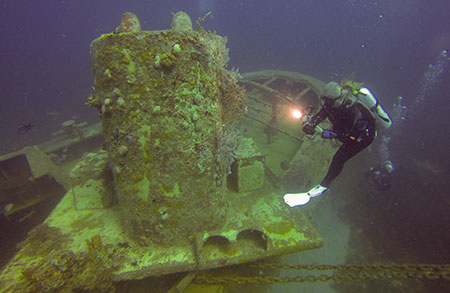
We negotiated the spread-out dive site, with swims through meadows of seagrass and somewhat silty slopes. We saw part of a sunken barge located a ways away from the Corinthian, then a sunken crane and, up on top of a sand chute a big bulldozer or crane, then made our way back through seagrass to the wreck, and then back up to the surface.
Given the water conditions we skipped the 4th dive. It would have been nice to return to the wreck of the River Taw where four years ago, in very poor visibility, I had lost the group and then had waited for them on what turned out the wrong mooring line. I had looked forward to the chance of seeing that wreck again in good visibility, but sometimes conditions just don't cooperate.
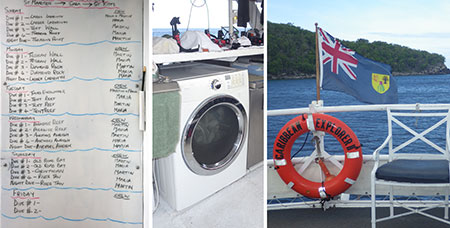
So I used the time to go over all of our cameras, changing batteries, uploading pictures, testing settings, and so on. Overall, none of the cameras had performed very well for us at all on this trip and I was reminded once again just how tricky underwater imaging can be.
For dinner we had truly exceptional pork loin, potatoes au gratin, corn, brussels sprouts, salad, and — as a big surprise — both a birthday cake for Carol and an anniversary cake for us! That was sweet and totally unexpected. I also received a congratulatory certificate for my 300th dive!
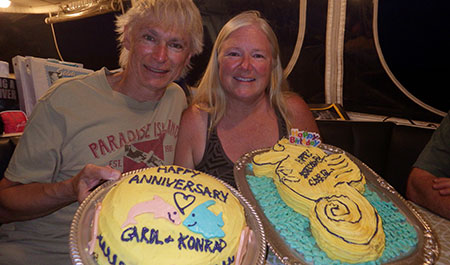
Captain Ian then informed us of what was going to happen for the rest of the week. Like us, the captain seemed to have a much better time than on the 2010 trip with its challenging weather and water conditions. He was relaxed, funny, and his dry wit and genuine concern for passengers having a great time was obvious. I can only imagine the load that must rest on a captain's shoulders.
For this night the boat was moored in what the crew called the “bedroom bay†where, for the first time on the trip, we didn't have any rocking at all.
Friday, June 6, 2014 St. Kitts — Friday morning we woke up after a mediocre night’s sleep. One of the passengers had mistaken the toilet bordering our state room for a phone booth in the night and proceeded to have a long, loud argument with some unfortunate party. I wish people would leave their cellphones behind on trips like this.
I wasn't sure if I wanted to do another dive because drying dive gear takes so long and with today’s pesky airline luggage regulations you can’t risk packing any extra water weight. But the weather was nice, the water looked clear, and I had good memories of the Monkey Shoals site between the islands of St. Kitts and Nevis where we were now moored. So I dove without the wetsuit, wearing just a t-shirt and a bathing suit. To compensate for the now missing buoyancy of the wetsuit I had dropped eight of the 16 pounds of weight I usually carried, and it turned out to be a delightful dive. Despite the lack of insulation I wasn't cold at all in the 80 degree water. The sun was shining brightly through the clear water onto the nice coral gardens and we saw a large southern stingray and also a flying guinard.
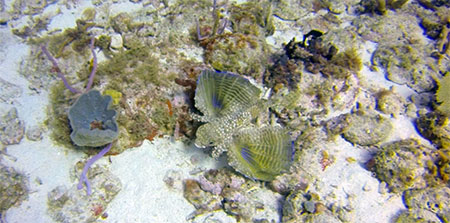
Should we go on the second morning dive as well, given that our plane left early the next day? Though our Uwatec dive computers showed just nine hours of no-fly time we decided to skip the last dive, with heavy hearts, to be closer to the generally recommended 24 hour no-fly rule. That also gave us extra time to take our dive gears on the upper deck for drying.
Jane's final lunch of the trip included cold cuts, cheese quiches, breaded fried shrimp, several cheeses, boiled eggs, and a variety of salads. During our meal, the Captain moved the boat from Monkey Shoals to the port at Basseterre where a giant cruise ship was also docked. I watched the challenge of properly approaching a crowded dock on a 110-foot liveaboard, slow down and turn, then align the boat with the dock and get close enough for having it fastened with three ropes. I can only imagine how difficult this is with a cruise ship.
In the afternoon we went on a ($30/person) tour of St. Kitts in Percy's blue Mitsubishi minivan. We knew Percy from our last trip. The man knows seemingly everyone on the island and always had a friendly question, an inquiry, or a kind word for everyone wherever we slowed down or stopped.
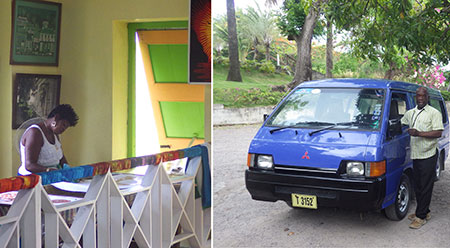
The tour took us through the center of Basseterre to its outskirts and the small settlements outside of town, past the St. Kitts Veterinary University, and some impressive churches from the era where the island had been divided into parishes.
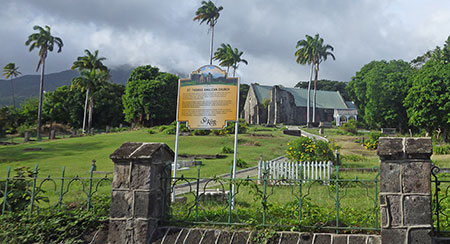
Cane sugar had been big business on St. Kitts, bringing fortune and riches to the island, but it was a cyclical business in the best of time, and one requiring high investment and reliance on a large labor force that at times consisted of indentured labor from Europe, other times on slave labor, and then, once slavery was abolished, on the work of those who had been freed.
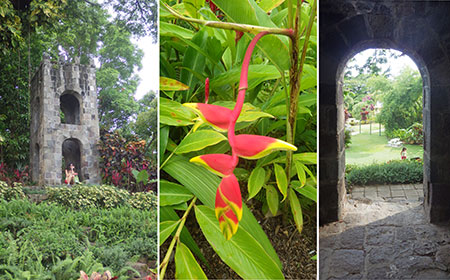
We visited a former sugar plantation that now houses, besides the partially rebuilt remnants of the sugar processing plant, also a famous Batik shop that we had not been able to visit last time because it was closed. This time it wasn't and they had nice things indeed. We bought several items, then had drinks at the attached outdoor bar and perused the most impressive rain forest surrounding and engulfing the property.
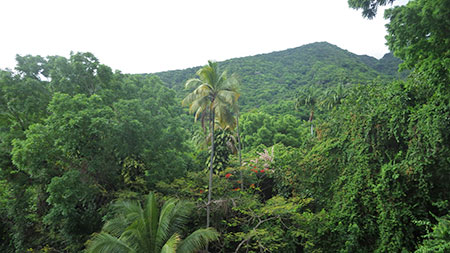
The forest, supposedly, had not been there during the sugar plantation era and had all sprung up in the last 100 years after the sugar plantation had long since closed down. I thought the massive lusciousness of the forest was interesting as I had read that the forest had been cut down to make room for sugar cane and had never properly grown back.
Then it was on to Brimstone fortress where, on the way up, we encountered herds of the little Velvet monkeys St. Kitts is famous for. They are small and very cute, and also quite shy. According to Percy, there are more monkeys on the island than people, though I am not quite sure how they ever counted the monkeys.
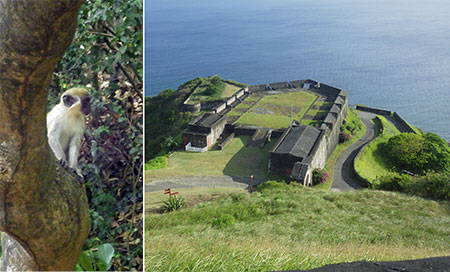
The fort itself was as impressive as I remembered (albeit perhaps in somewhat worse repair than it was four years ago) and an incredible architectural feat, given its location and engineering resources available at the time it was built. There were also a good number of exhibits explaining history, as well as customs and conditions at the time. I wish we'd had more time to take it all in.
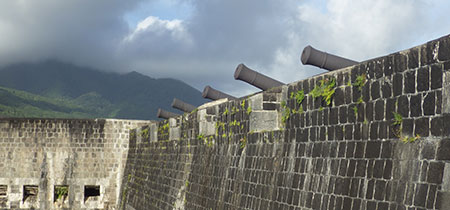
Overall, the entire island of St. Kitts is a fascinating place with as much history or more than any other island in the Caribbeans. The island has awesome natural beauty and seems near paradise, a fact perhaps a bit lost on some of today's population.
Driving back to the ship through the crowded streets of Basseterre was tiring, and once we arrived I no longer had any desire to go out and have dinner at a local restaurant. So Carol went and I stayed behind, first having a nice conversation with Jane the cook, then taking a hot shower and packing up the remainder of our gear and belongings.
Saturday, June 6, 2014 St. Kitts to Sacramento — The wakeup call came early at 5AM for our 7:40AM flight at the airport right outside of Basseterre. The trip was over much too soon and I missed the Caribbean Explorer II and our new friends onboard as soon as we stepped into Percy’s cab. It’d been great to experience this itinerary under weather conditions vastly better than we’d had four years prior. And I can't even begin to describe how impressed we were with the crew, which was not only supremely competent, but made us feel welcome, appreciated, and well cared for.
One bad thing about even the most wonderful dive trip is the travel involved. Getting there and getting back used to be half the fun, but not anymore. Not with airlines seemingly determined to make flying as uncomfortable and inconvenient as possible, and piling on ever more fees and extra charges. We flew back from St. Kitts to Miami where we had two hours between flights and needed every minute of it to make it through cumbersome immigrations, then on to Charlotte, way out of the way, and then a long final leg to Sacramento. By the time we were home we’d been up 22 hours, cranky, exhausted, and swearing we’d never, ever fly again.
But, of course, we will. And the airlines know it and will be ready with even more fees, even harder seats, and even less service and more inconvenience. And we’ll grin and bear it. Because we know that once we’re there we’ll have a great time.
Posted by conradb212 at 10:19 PM
May 29, 2014
After the book
It's been forever since my last entry, and it seems like forever since my last dive.
After several years of averaging 40 to 50 dives a year, last year was dismal. It began well enough with a nice week in Florida where we visited all of our old haunts and favorite places. A week in Cancun in early summer proved a bust as it rained almost constantly and I only got four dives in. We did go up to Lake Tahoe in the Fall for a nice dive, and then had plans to spend a week on Roatan in December. That never happened, mostly because airline booking and pricing has reached new levels of insanity.
But mostly it has to do with finishing my book on scuba. Working on "Becoming a Scuba Diver -- From Pool to Sharks: Journey and Reflections of the First 250 Dives" had been a constant presence in my life and I was always eager to add another experience, reflect on another aspect of diving, and report on the latest dive trip.
Learning how to convert all those blog entries and notes into a cohesive book via Amazon's CreateSpace was an experience in itself. Proof-reading was just as tricky as I remember from the years when my job was publishing magazines. Then there was doing the cover, finding the right font, picking a physical size for the book, and laying it all out. Good thing I remembered how to use Quark XPress. At the end it was 365 pages, a pretty sizable book. Getting the first actual, printed proof copy of the book in the mail felt great. Then there was another proofing and editing pass, and it was done.
One of the wonderful things about modern self-publishing is that you don't have to shop your manuscript around to publishers, competing with numerous other authors for their interest. And you don't need to commit to printing so and so many books that may or may not sell. That was always a problem with publishing magazines. We never knew how many of the thousands and thousands of magazines we had printed would actually sell in bookstore and on newsstands.
So the book was done and though I knew better I thought now I could just sit back and wait for sales to roll in. People interested in scuba would find it on Amazon and buy it. Sadly, not so. A few books sold, but really just a token few. That was disappointing. But without marketing a products, that's the way it is. I had planned on notifying as many dive shops as I could in the hope that they would stock and sell the book, as most dive shops do. And I needed to do a proper press release, send out review copies, try to get media coverage and book reviews.
But somehow I didn't do any of that. It was as if I had expended all the creative energy in writing the book and bringing it to print. I had nothing left after that, not even taking the easy extra couple of steps of making it available in Kindle format. Months went by, and it's easy to forget how the CreateSpace process works if you're not at it every day, and so on and so on.
The other weird thing was that after the book was done and I had received a box of copies to give to friends and family, there was this odd sense of being done with the project. I still wanted to go dive, but the urgency seemed lessened as writing about places, dives, and gear was lessened. The book was done.
If you're really into something it tends to take over your life. Knowing all the ins and outs of a hobby, sport, passion comes natural. It's only afterwards that you realize how complex and involved it all was, and how easily one forgets, and how difficult it is to get back in.
So that's why there haven't been any new entries in this blog. We haven't gone diving. I'm frustrated over having let the finished book sit so long without publicizing it properly. And I am also frustrated ver not having gone diving in over eight months.
But the wait is over now. In a couple of days Carol and I will be leaving for the island of St. Maarten, where we'll board the Caribbean Explorer Explorer II for a week of diving off Saba and St. Kitts. We did that almost four years ago, albeit the other way around, starting in St. Kitts and ending up in St. Maarten. It'd been in the aftermath of a big storm and the water had been stirred up and not very pleasant. This time, I hope, conditions will be much better.
Posted by conradb212 at 2:49 PM









